Five Ways You Can Donate to Charities in Croatia in Time for Christmas
December 14, 2022 - Christmas time often inspires generosity. In Croatia, like in many other places, it is the right time for dinners, receptions, parties, and events organised for charity. There are plenty of those happening all around the country, but there are also many other ways to practice helping those in need. For this holiday season, we are presenting some of the charities in Croatia which accept donations and help. You can, of course, donate and help any other time as well.
The Croatian Red Cross
The international Red Cross movement is one of the best-known humanitarian organisations in the world. With a branch in every Croatian county, they are easily accessible and help by acting in every aspect of life where help might be needed. From providing first aid education and blood donations to crisis preparedness and ecological protection, the list of everything they do is quite long and all-encompassing. The ways in which everyone can help include donating blood, household items, and money, volunteering, or becoming a member. You can do that from the position of an individual, a company, or an organisation. The donations part of their website has all the useful information in English, including their account info and a list of needed aid items.
SOS Children's Village (Dječje Selo) Hrvatska
The SOS Children's Village Croatia Association has been operating since February 25, 1992, as an equal member of SOS-Kinderdorf International, the world's largest non-governmental organisation that operates in 135 countries around the world. The executive part of the SOS Children's Village Croatia Association consists of the National Office, which coordinates all SOS programs in the country. Besides volunteers and hands-on help, the organisation accepts one-time, as well as regular donations, of products and services or money, by individuals or companies. One-time donations can be made using the information provided here, and you can use cryptocurrency to do so as well.
The Perfect Circle (Savršen Krug) Humanitarian NGO
The humanitarian organisation Perfect Circle (Savršen Krug) regularly provides children in student homes, families with many children, and families with elderly and vulnerable people with clothes, food, and hygiene items. They are organising a Christmas action to help children, young people, and socially disadvantaged families, which lasts until December 23.
This year, the plan is to brighten the holidays for 230 families with children and 30 children and young people without adequate parental care.
Last year, in this way, they helped 140 families with children and 50 children and young people. They distributed over 150 packages but, unfortunately, did not collect enough monetary donations. They are optimistic this year and hope to collect almost twice as many packages!
Collection of monetary donations, as well as donations of food items, is underway. This December, the plan is to distribute around 300 Christmas packages in seven counties.
If you would like to donate food and hygiene items, you can follow the list provided on the website and by calling Aleksandra at +385 91 3773 771. If you would like to make a monetary donation, you can use the account information below:
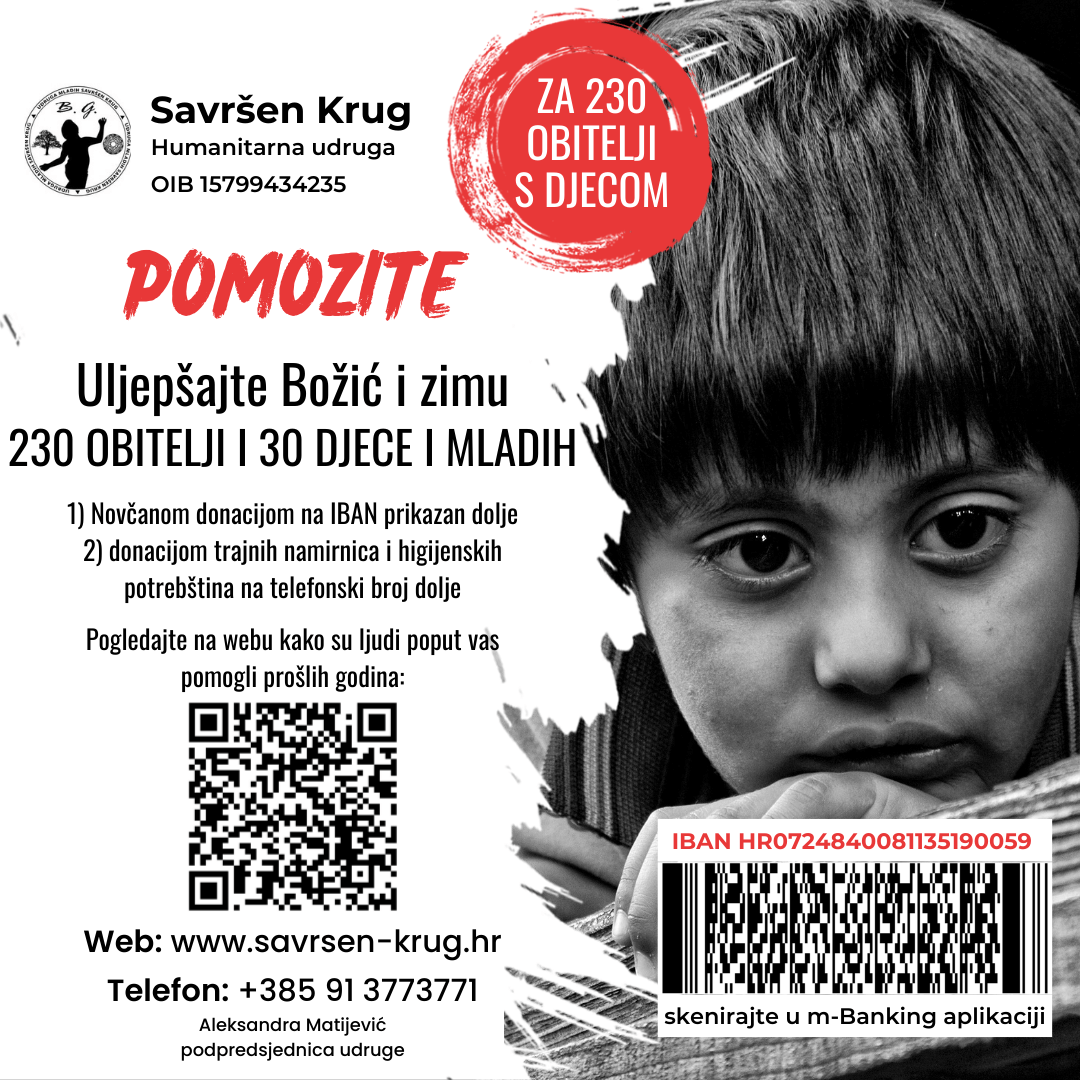
BEA Centre for Eating Disorders
With a donation to Rijeka's Bea Centre, you can help provide psychological help to people suffering from anorexia, bulimia, and non-specific eating disorders. Children and young people suffering from anorexia and bulimia usually hide their pain; they think that no one understands them and that the world does not care about their suffering. The BEA Centre is there for them, offering free advice and conversations with experts.
Your donation will provide a free consultation for a child or young person suffering from an eating disorder who will receive support, understanding, and expert advice on further treatment. You can donate directly to their bank account using the information provided below:
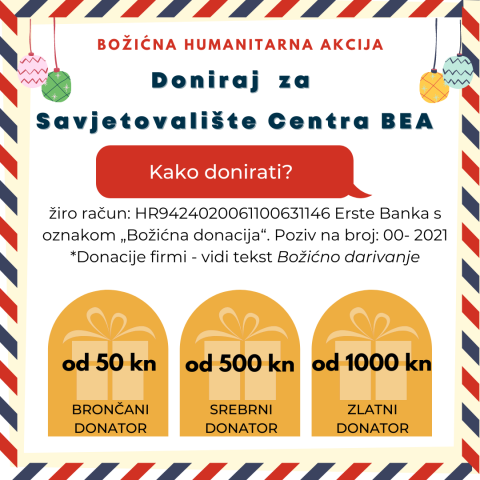
Pula: Christmas stand of the Homeless Shelter
As part of Pula's December in the City, a stand with Christmas wreaths and decorations whose profits will be directed toward the users of the Homeless Shelter has been set up at the market. The products were made in workshops throughout the year.
As Glas Istre wrote, the donations were one year used to buy a television, another for a clothes dryer, and there was something left over for pocket money for the volunteer Vesna Biritteri, who has been volunteering at the stand and the Shelter for 12 years. Now retired, she used to work at the homeless shelter as well.
She says that the turnout of Pula's residents is always very good, and so is this year. At the start of December, you might have visited the stand at the market, from where it moved to a small stall at Giardini with a more generous offer, including handicrafts, knitted scarves, hats, and leg warmers.
For more, make sure to check out our dedicated Lifestyle section.
Croatian Traditions: Planting Christmas Wheat on Saint Lucy's Day
December 13, 2022 - Croatia is a largely Catholic country, and as such it has many traditions tied to saints, including various Christmas traditions. One of them is Saint Lucy's Day, which is today, on the 13th of December. The Croatian tradition for this day includes planting a little pot of Christmas wheat, which will serve as part of the decorations for the Christmas table.
As Večernji wrote, although pots of wheat can be bought for almost symbolic amounts at markets and in all retail chains, the process of planting wheat is part of a tradition that takes most Croatians back to their childhood, family gatherings and the immense joy of waiting for Christmas, which, unfortunately, seems to be slowly disappearing.
The planting of wheat in the Croatian Christmas tradition carries a deeper meaning: besides being a symbol of the birth of new life and well-being, it invokes and blesses the harvest. The belief is that the appearance of the wheat (colour, density, height) would predict what the crop in the following year would be like. In some regions, in addition to the Saint Lucy's Day, wheat is traditionally sown on Saint Barbara's Day, December 4, following a different process as well. The common goal, though, is for the Christmas wheat to grow tall and dense to be proudly presented on the Christmas table, and many people keep it until the New Year.
Although growing it should be a simple process, it seems that there are a few tricks to growing a fruitful, dense pot. That is one of the reasons why many Croatians decide to buy ready-made wheat a day or two before Christmas. Agronomist Sunčica Dombaj shared a few tips. She mentioned insufficient seed germination and growth in unfavorable conditions as the main cause for thin or low wheat. "It would be ideal to keep the wheat at a moderate temperature in the room by the window, that is, in a bright place, and not to overdo it with watering", she emphasized, adding that the wheat should be watered daily, but moderately, by spraying it with a sprayer or simply misting it with your hands soaked in water. Otherwise, the leaves will turn yellow and mold will catch on the wheat. It is important that the container in which you put the wheat is not too deep - some plant it on a plate.
How to plant your own Christmas wheat
Put a layer of garden soil in a shallow container and gently press the germinated wheat seeds in and spray daily. In addition to light, wheat also likes heat, but do not place it directly next to a heat source, radiator or stove. Wheat grows well on cotton wool - many people use this trick. Put a layer of cotton wool about one centimeter thick in a bowl, spray it with water and spread the grains of wheat over it. The method of care is the same as for wheat that is planted in soil. Planting wheat is a perfect activity to do with children, who will then eagerly monitor and follow the progress of the wheat throughout the 12 days before Christmas.
What should you pay particular attention to when planting wheat?
Wheat, regardless of whether it is planted on an earthen substrate or a cotton substrate, should not be sown too thickly, because then a lot of sprouts pop up and elongate in search of a place to grow.
After it germinates and starts to grow, how do you keep wheat green until the New Year?
Wheat's greatest ally in maintenance is moisture. Sunčica advises that instead of watering, wheat should be moistened by spraying and that the soil should not be allowed to dry out. Also, wheat should by no means be supplemented.
Did you know that you can eat the green part of wheat?
Many people grow wheat this way throughout the year. The reason for this is its health benefits in the daily diet. You can also use it in the preparation of your meals - simply cut the green part with scissors and put it in a salad or mix it in yogurt or some kind of drink.
For more, make sure to check out our dedicated Lifestyle section.
Bogojavljenje (Epiphany) - Three Kings Day in Croatia
January 6, 2022 – Thursday 6 January is Bogojavljenje (Epiphany). Three Kings Day in Croatia is a national holiday. It is also a day marked by its own historic and very distinct traditions.
With the fireworks of New Year's Eve almost one week behind us, Christmas already feels like it was quite a while ago. But, with church bells ringing out across the land, Three Kings Day arrives on 6 January to remind us in Croatia that we're not quite finished yet.
Commonly known as Bogojavljenje (Epiphany), Three Kings Day is highly significant in the Catholic calendar. It is also a day of limited but extremely distinct tradition in Croatia. Understanding these traditions requires a comprehension of some Bible scriptures. More so, perhaps, than the traditions of any other feast or celebration days connected to Christmas.
What is Bogojavljenje (Epiphany) - Three Kings Day in Croatia?
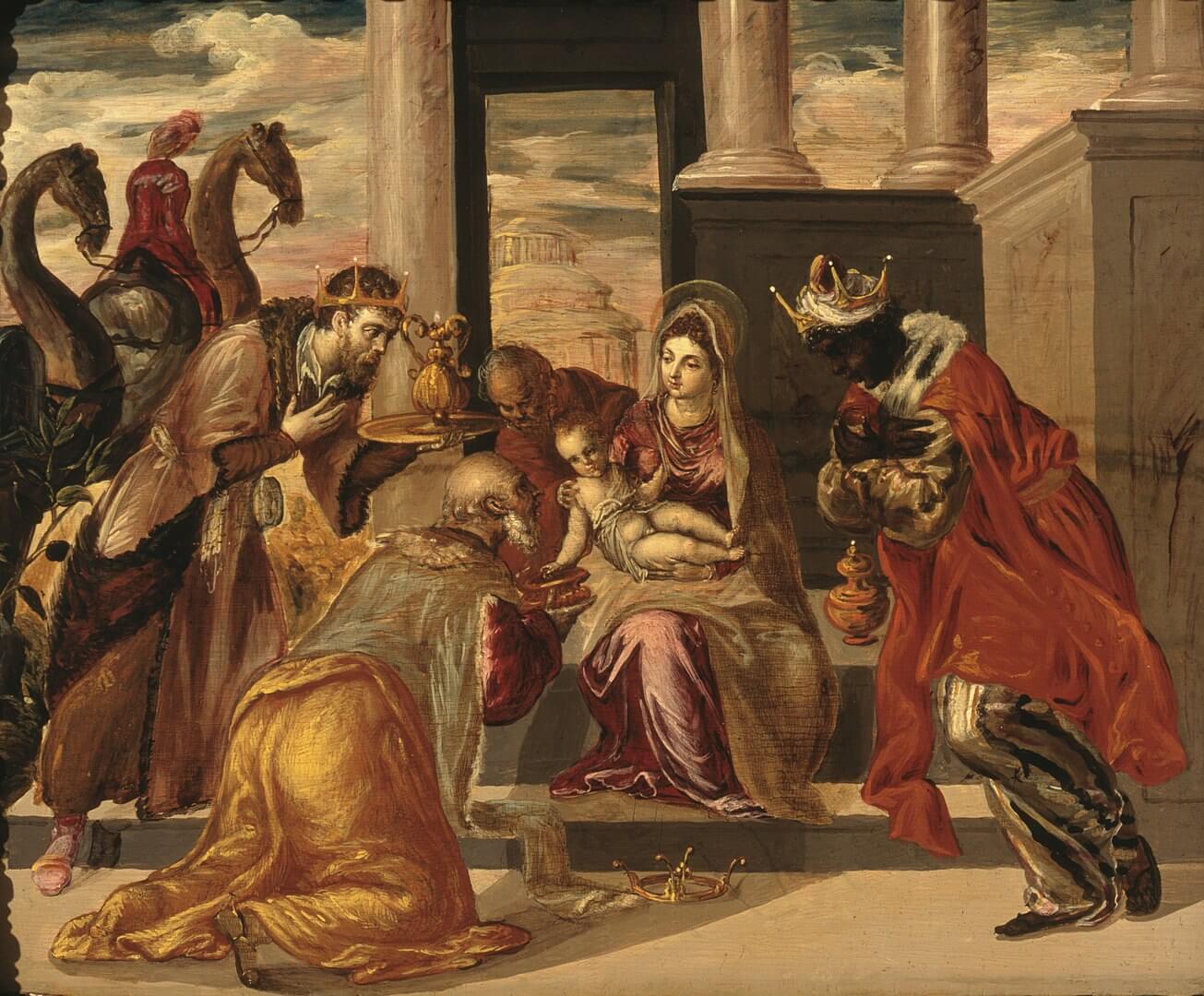 Adoration of the Magi by El Greco
Adoration of the Magi by El Greco
January 6 is celebrated in the Catholic church as both Epiphany and the day of the Three Kings. Epiphany is the revelation of Jesus as the Son of God to those outside Judaism. Three Kings Day is when the three kings – otherwise known as Magi or the three wise men - visit the newly-born Jesus and present gifts to him.
These could look like two different celebrations that just happen on the same day. But, in fact, they are not at all separate. Although, their connection does take some explaining. And the traditions the day creates in Croatia takes even more explaining.
Who are the Three Kings aka the Three Magi?
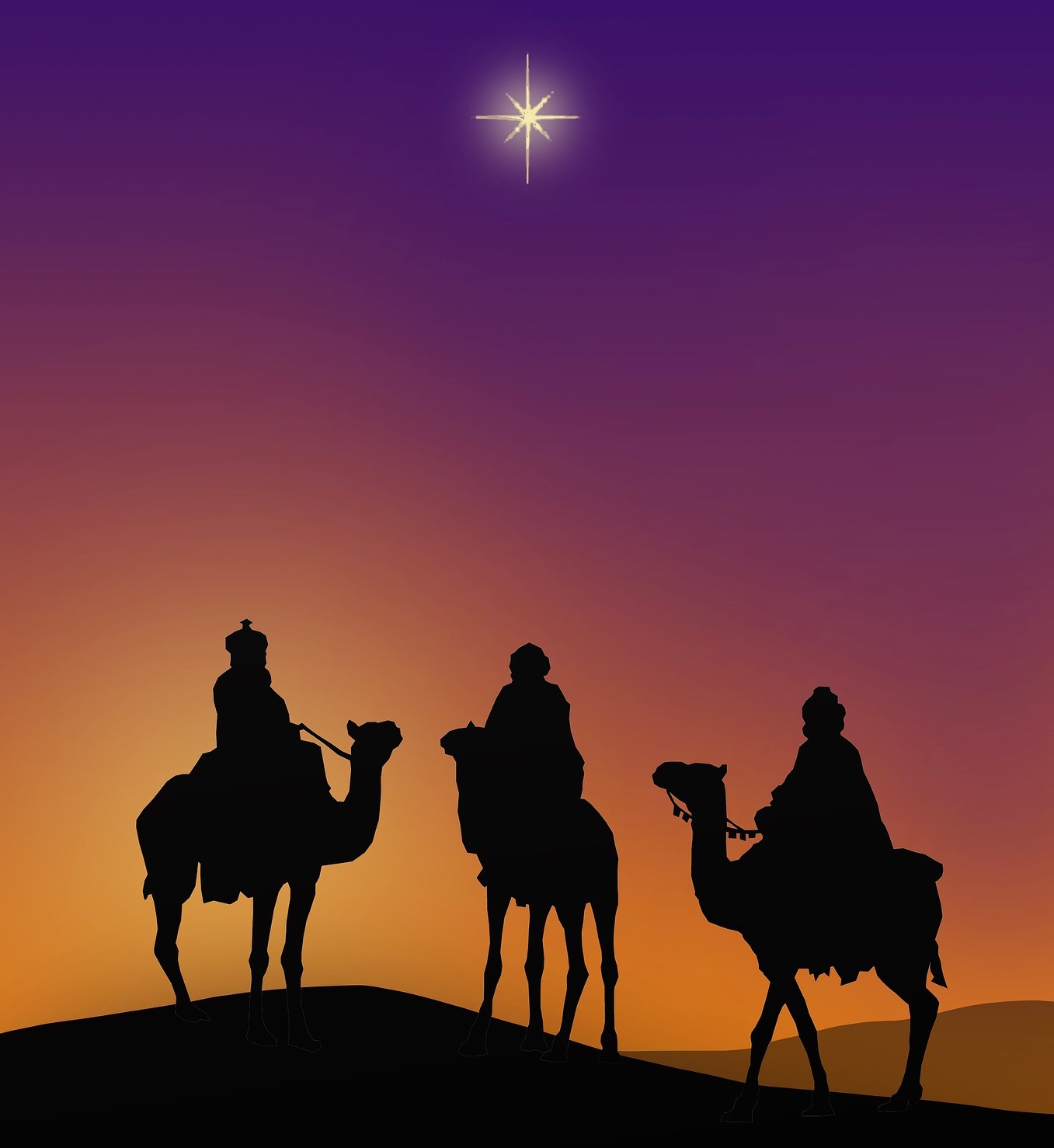 The Magi, celebrated on Three Kings Day in Croatia
The Magi, celebrated on Three Kings Day in Croatia
If you've seen a nativity scene or any Christian art related to Christmas, you'll be familiar with the image of the Three Kings. But, actually, they are not in the Bible. What the Bible says is, Magi arrive in Jerusalem at the time of Jesus's birth. They ask the location of the 'king of the Jews' so they can pay tribute. No number is allocated to the Magi.
However, the Bible details that the Magi carry with them three gifts for Jesus – frankincense, gold and myrrh. It is from this number of gifts that the embellished western tradition presumes the number of Magi. In the eastern church, the number of Magi is actually set at 12!
Their number is not the only way their story has been enhanced. Over the years, the Magi have been given very different places of origin. In some of the first embellishments, the kings are said to represent lands of Arabia, Persia and India. But, as Christianity spread, the story changed – perhaps to be either more inclusive or reflect self-importance. Later versions have the kings representing Asia, Africa and Europe. The Bible actually says all three arrive from the east (Africa and Europe are obviously not east of Judea.)
From the 8th century we find the first evidence of the Three Kings being given names - Balthasar, Melchior, and Gaspar (or Casper). In the Bible, the Magi follow a star to reach Jerusalem at the time of Jesus birth. But, they stop and ask directions. Three Kings Day is when they finally arrive to pay tribute to Jesus.
In our celebration of Christmas, this is 12 days after the birth of Jesus Christ. And yet, in every nativity and Christmas painting, shepherds attend the scene immediately after Jesus's birth, closely followed by the Three Kings. To understand what is happening with the Three Kings and the Epiphany you need to look at the Gospel according to Matthew.
Understanding the Gospel according to Matthew
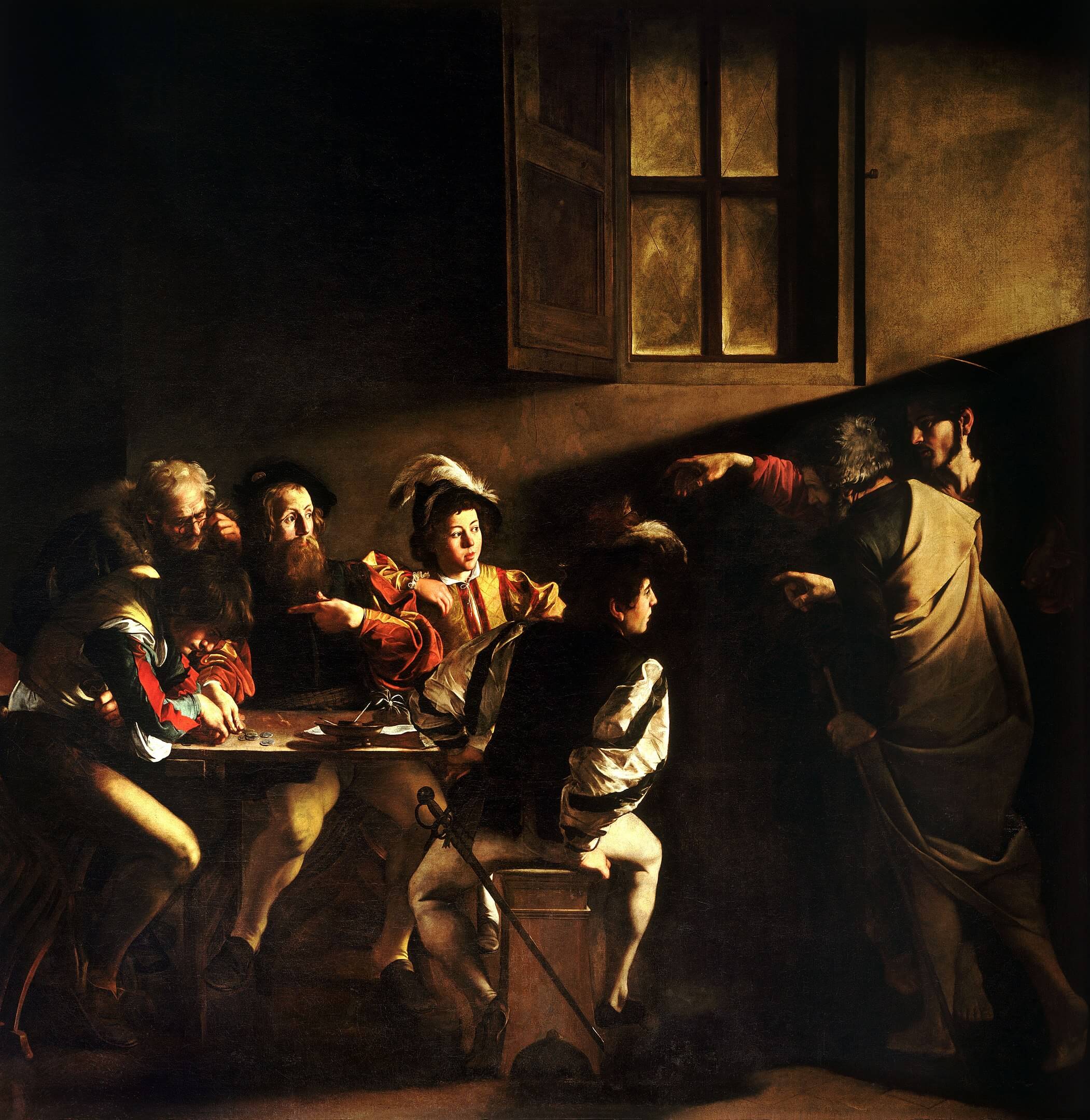 The Calling of St Matthew by Caravaggio
The Calling of St Matthew by Caravaggio
The first three books of the New Testament are Matthew, Mark and Luke. When originally written, they were not intended to be placed next to each other in a single compiled 'book'. And so, within the first three books of the New Testament, we find quite a lot of repetition, as each of these disciples recounts the life and story of Jesus.
The Gospel according to Matthew is arguably the most famous and most detailed of these books. As an example, it is the only book where we are told about the Magi visiting Jerusalem and Jesus. It is also the most Jewish of the Gospels - in structure and in language (it is originally written in Greek).
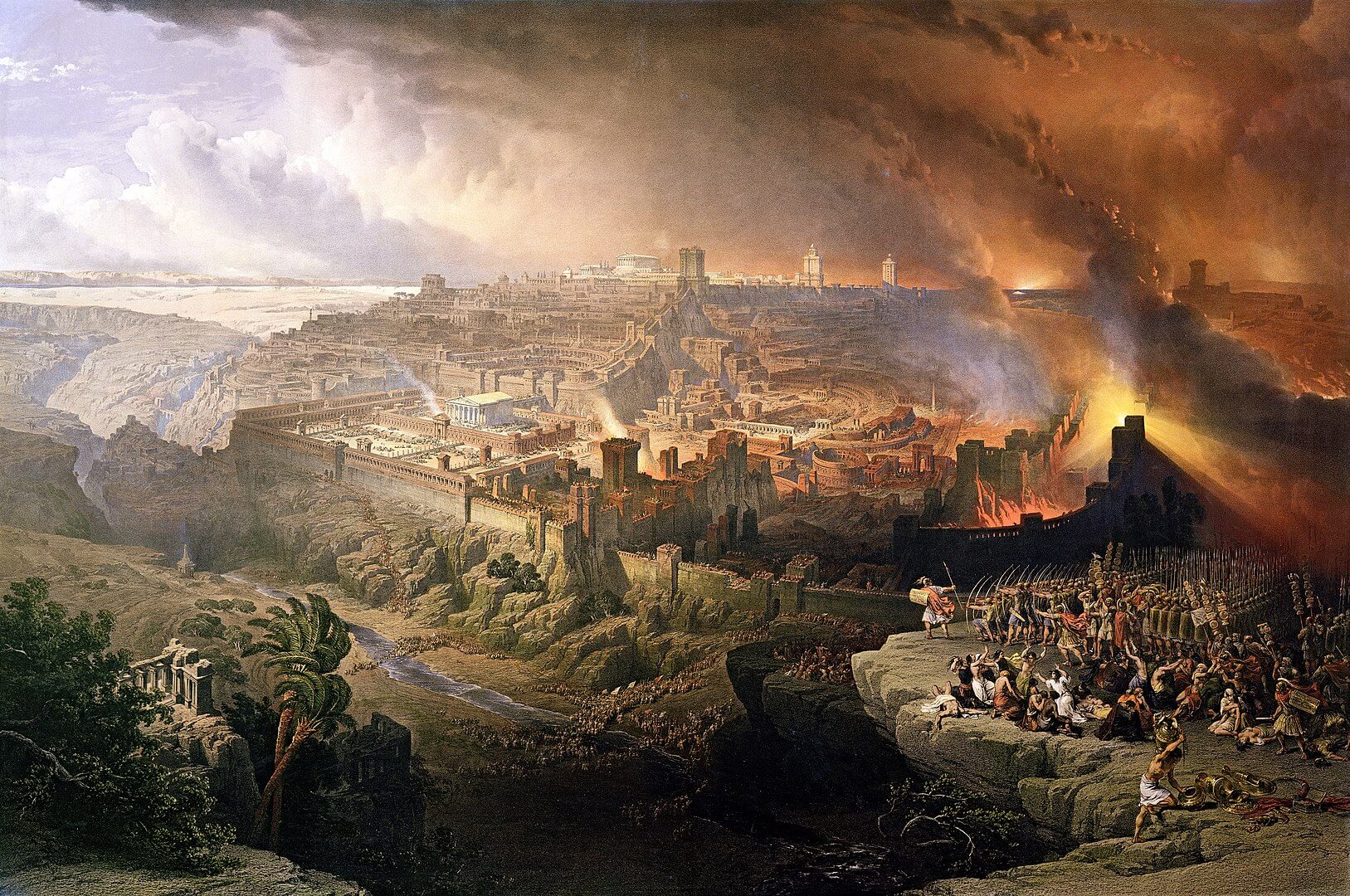 The Siege and Destruction of Jerusalem by the Romans Under the Command of Titus, by David Roberts
The Siege and Destruction of Jerusalem by the Romans Under the Command of Titus, by David Roberts
The books of both Luke and Matthew take from the book of Mark, which is widely considered to have been written first. Most scholars today agree that Matthew was written sometime between AD70 and AD100, not by Matthew himself, but by his followers. If accurately dated, the book is written within recent memory of the destruction of Jerusalem and its Jewish temple by the Romans in AD70.
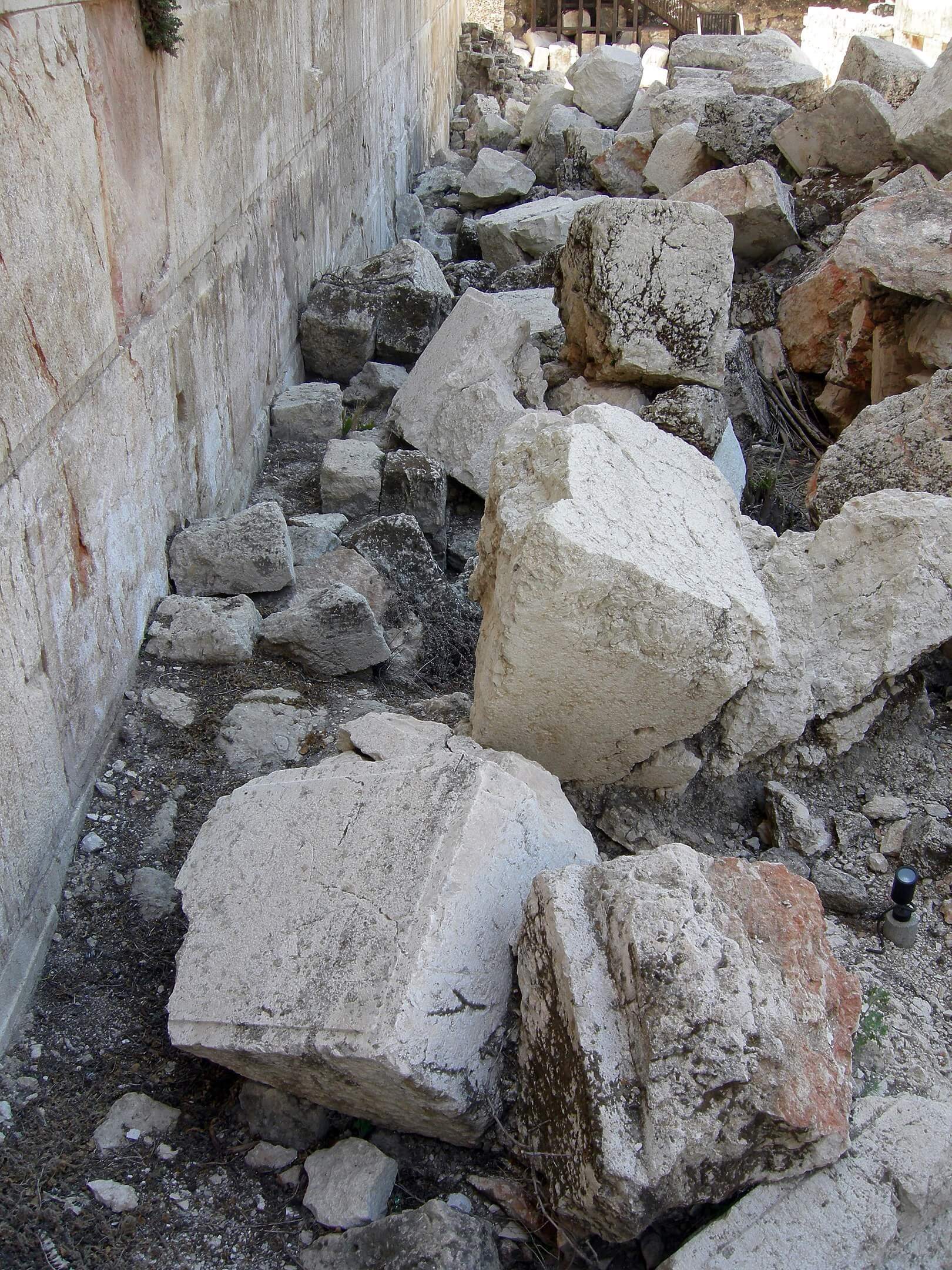 Stones from the Western Wall of the Temple Mount (Jerusalem) thrown onto the street by Roman soldiers in AD70
Stones from the Western Wall of the Temple Mount (Jerusalem) thrown onto the street by Roman soldiers in AD70
In the lifetime of Jesus, His ministry was limited to the land of Judea. Thereafter, the ministry of Matthew was similarly aimed towards Jews. The Gospel according to Matthew begins by carefully detailing Jesus as a descendant of David and Abraham. This is necessary in order for Jesus to be the Messiah spoken of in Jewish prophecy.
Several times in the gospel, Matthew is critical of Jewish Pharisees. But, he is not trying to replace Judaism with a new religion. Instead, he says Jesus is fulfilling Jewish prophecy. He instructs that Jewish scriptures should be more closely adhered to by the followers of Jesus (than they had been by 'hypocritical' Pharisees).
And yet, at the time it was written, a certain separation must have existed between Matthew's followers and many Jews simply because Matthew's followers insisted Jesus was the Messiah. The Gospel ends with the resurrected Jesus instructing “go and make disciples of all the nations". Therefore, Matthew pre-empts the spread of the faith and stands as a bridge between Judaism and the new church. No doubt, this is part of the reason Matthew is the first book of the New Testament instead of the earlier Gospel of Mark.
That the kings come to pay tribute to Jesus in Matthew further fulfils Jewish messianic prophecy. It also positions Jesus as the Son of God for gentiles (non-Jews).
Blagoslov obitelji (family blessing) and the traditions of Epiphany (Bogojavljenje) Three Kings Day in Croatia (Sveta tri kralja)
 Bogojavljenje aka Three Kings Day in Croatia, by Dusko JaramazPIXSELL
Bogojavljenje aka Three Kings Day in Croatia, by Dusko JaramazPIXSELL
Traditionally, this is the day on which your local priest would visit your home to bless it and the family within. Nowadays, Croatia's population has grown so as to make this impossible. So, in the modern era, the annual blessing of home and family take place between St. Stephen's day (here) and today.
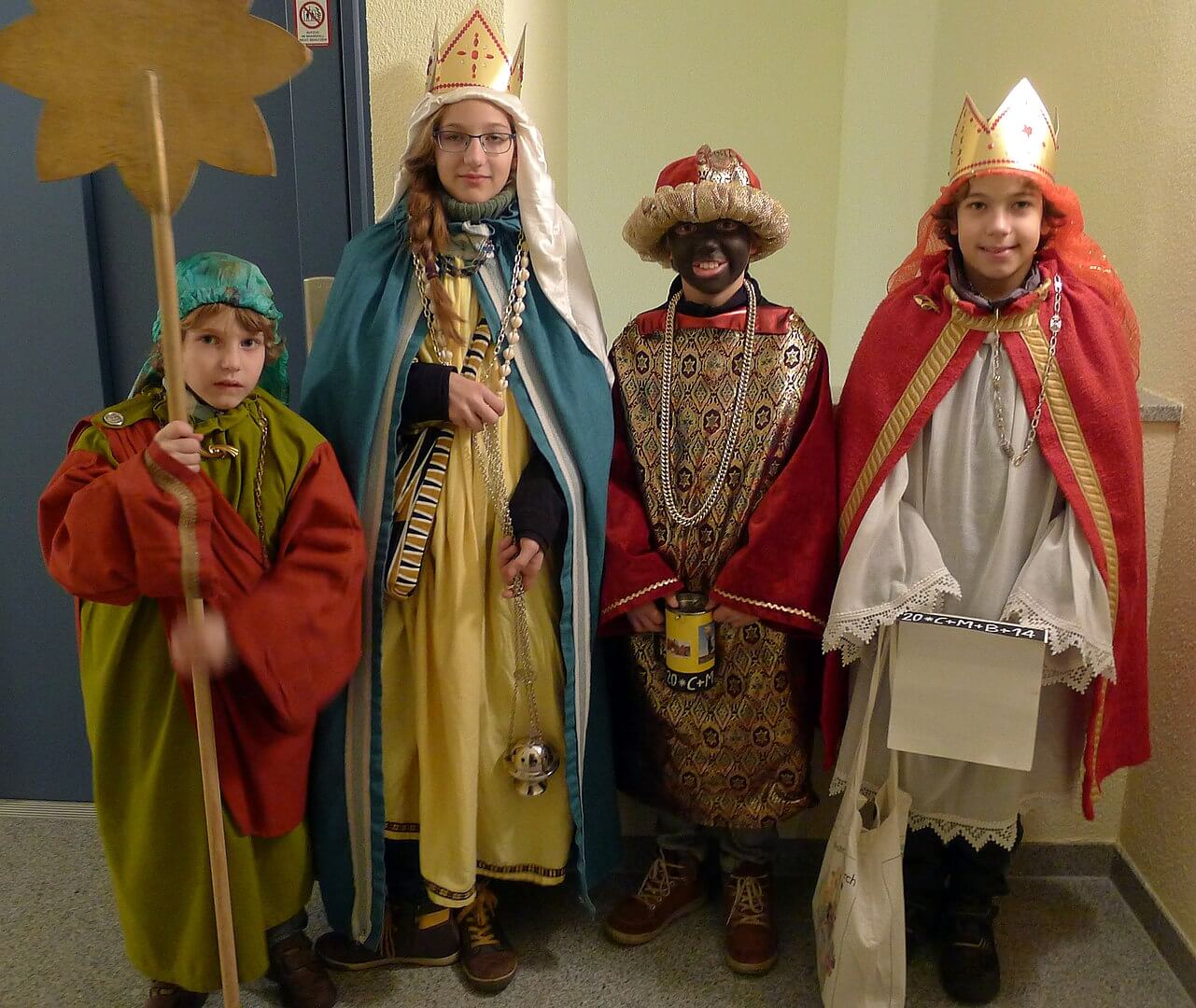 Zvjezdari in Germany, by James Steakley
Zvjezdari in Germany, by James Steakley
This is still a day of Christmas, celebration and decoration. Traditionally, the priest may have been accompanied by altar boys who rang bells to let villagers know they were on their way. These days, the altar boys could be choristers or simply young parishioners. It is not uncommon for them to sing and to be dressed as the Three Kings and carrying a star (Zvjezdari – starmen).
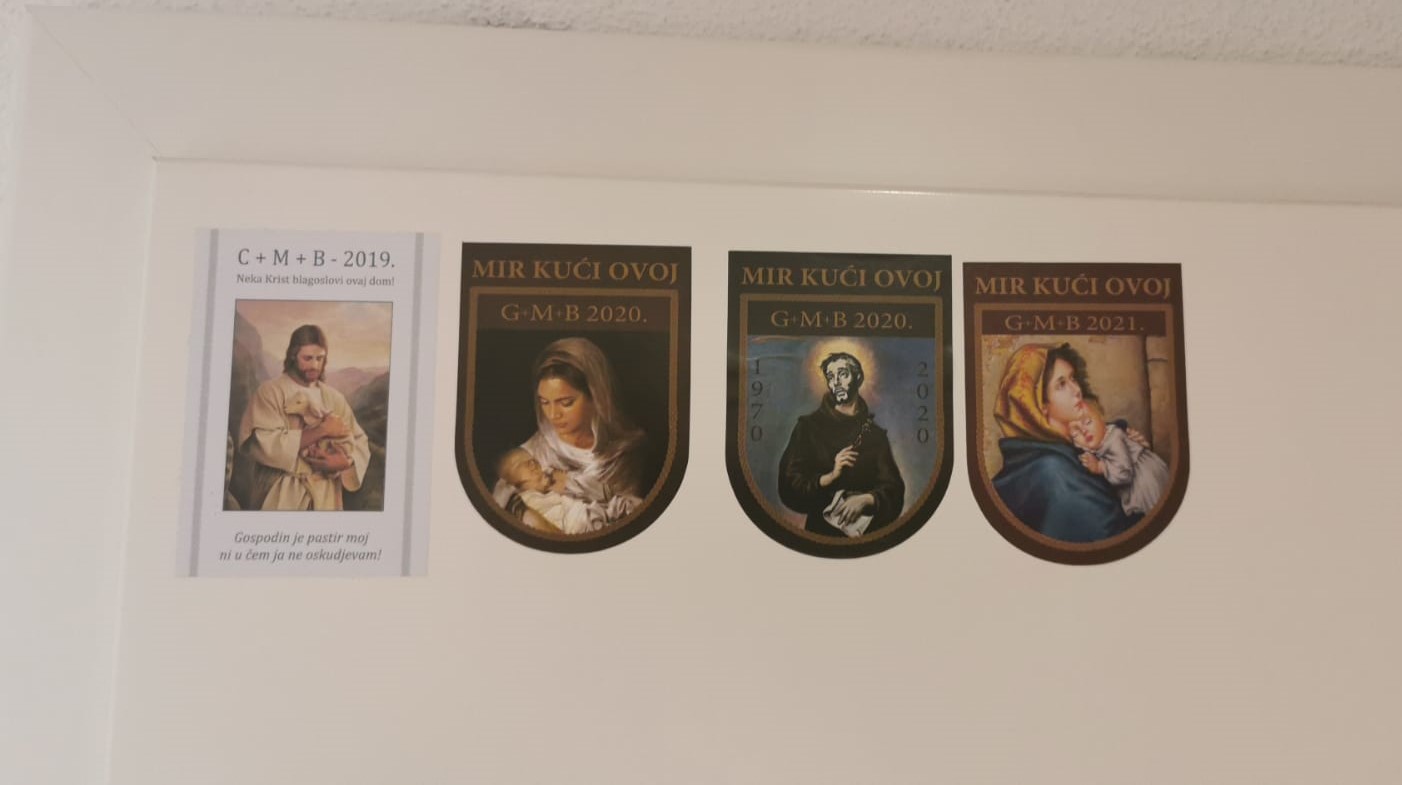 Collection of stickers marking Blagoslov obitelji (family blessing), awarded on Three Kings Day in Croatia. Note the different spelling of Saint Gaspar (Croatian) / Caspar (Latin)
Collection of stickers marking Blagoslov obitelji (family blessing), awarded on Three Kings Day in Croatia. Note the different spelling of Saint Gaspar (Croatian) / Caspar (Latin)
As part of the home blessing, it was traditional for the priest to sprinkle the home with Holy water. Also, he would write in chalk above the main entrance to the home. The chalked pattern would read 20 ✝ C ✝ M ✝ B ✝ 22 - numbers denoting the year, and the cross separating the letters C (G), M and B. These are the initials of the Magi Caspar (Gaspar), Melchior and Balthazar. They are also an abbreviation of the Latin blessing Christus mansionem benedicat - May Christ bless this house. This chalking of the door signals the home has been blessed for the year and echoes the Old Testament marking of doorways by the Israelites in Egypt. As in Matthew, the tradition of Three Kings bridges Judaism and the new church. Nowadays, the chalk writing has in most instances been replaced by stickers.
 Collection of stickers marking Blagoslov obitelji (family blessing) - these will be added to on Three Kings Day in Croatia
Collection of stickers marking Blagoslov obitelji (family blessing) - these will be added to on Three Kings Day in Croatia
In the distant past of Three Kings visits, a greater significance was put on the blessing of the home and property. But, in order to diminish the supernatural aspect of 'warding off bad spirits from the home', the church has continuously aimed to make the blessing more about the family gathered within. These days, that is reflected in the contemporary wording of the blessing.
This family aspect of the blessing actually goes back an incredibly long way. This time of year is one of the least demanding for those who work in farming or agriculture. It was easier to gather together the full family for the blessing at this time than at almost any other during the year. This tradition still exists – it is customary for the full family to be gathered together when the priest visits.
Another tradition that persists is the cleaning of the home prior to the visit. Although, this is not only because the priest is coming. Remember, Bogojavljenje is Jesus's revelation as the Son of God to all those outside Judea and Judaism – as represented by the Three Kings.
The Three Kings give the gifts of frankincense (signifying his origin from God), gold (signifying his royal status on earth) and myrrh (a balm, signifying that Jesus is a man). The cleaning and blessing of the home welcomes Jesus into Croatian home – as a man he walks among us.
In the modern era, it is customary for the family to give a monetary donation to the priest at the time of the visit. This is not traditional nor is it 'payment' for the blessing or visit. God's blessing cannot be bought or paid for, and is not denied to anyone who asks for it - whether he had money or not. That the traditional annual donation takes place on this visit is a matter of convenience.
Non-Croatian traditions of Epiphany (Bogojavljenje) Three Kings Day in Croatia (Sveta tri kralja)
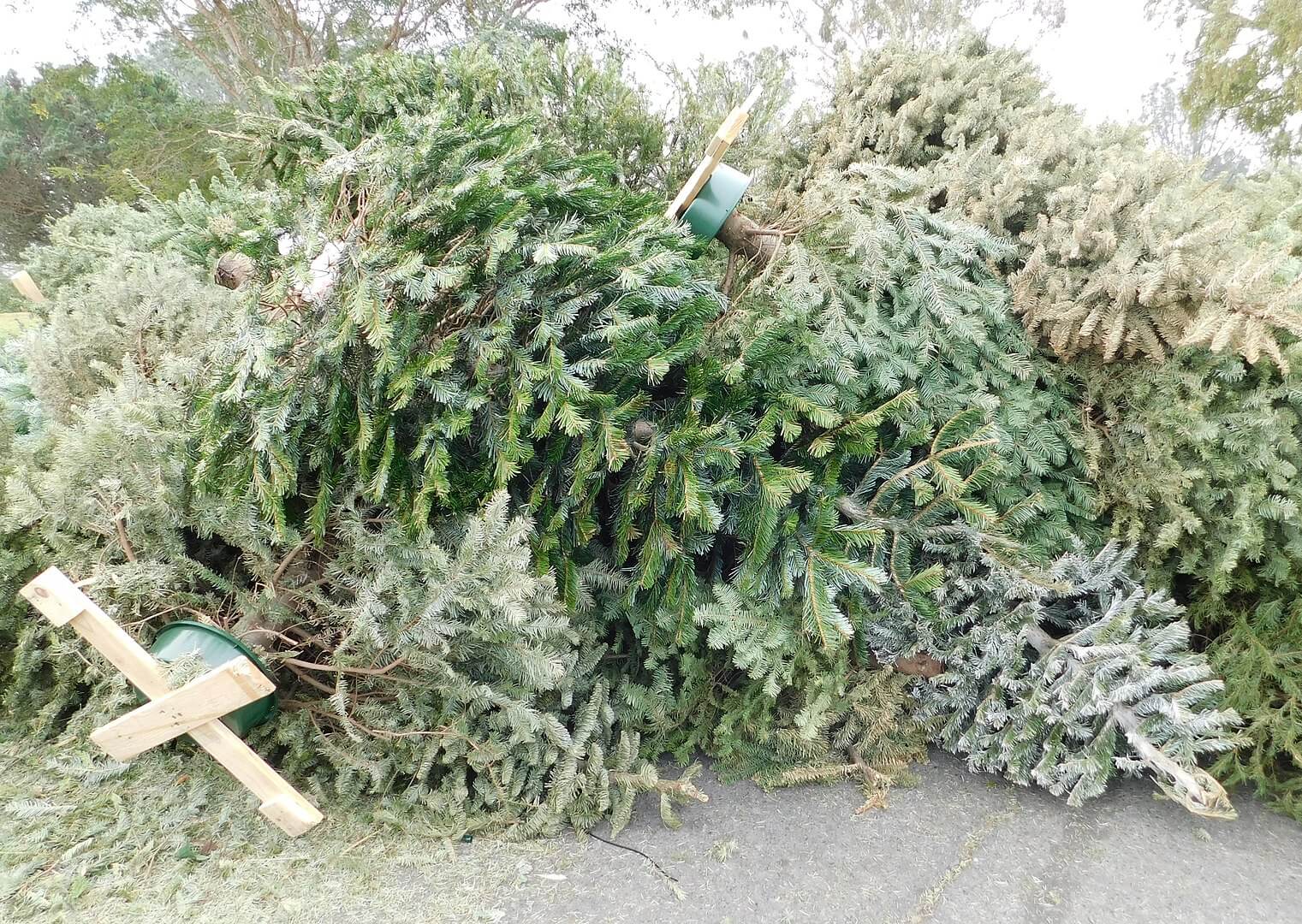 Christmas tree recycling, by Ruff tuff cream puff
Christmas tree recycling, by Ruff tuff cream puff
Bogojavljenje is one of the oldest Christian holidays marked in the Croatian Catholic calendar. The fact the day remains a national holiday in Croatia attests to its continued importance.
The laziest and most incorrect contemporary 'custom' attributed Croatian Bogojavljenje is that it's the day you should throw out your Christmas tree and take down your decorations. Wrong. The second biggest modern error is to regard Bogojavljenje as the end of Christmas.
The Christmas tree is not a traditional part of Croatian Christmas. It is German. Its widespread popularity only really began from around 1850 in the UK (thanks to their German monarchy importing it) and from 1870 in the USA. Only after that did the custom travel internationally. To regard the discarding of Christmas trees as a fundamental part of a centuries-old tradition displays an extremely limited and shallow knowledge of Croatian traditions.
In fact, it is Croatian tradition for the local priest to visit the family with the home still decorated. Typically, the priest was fully embraced into the family Christmas setting when he called – jaslice (nativity), candles, log fire, decorations and all. In the past, the priest was usually offered food and drink from the family. In many instances, they would all enjoy the seasonal food together.
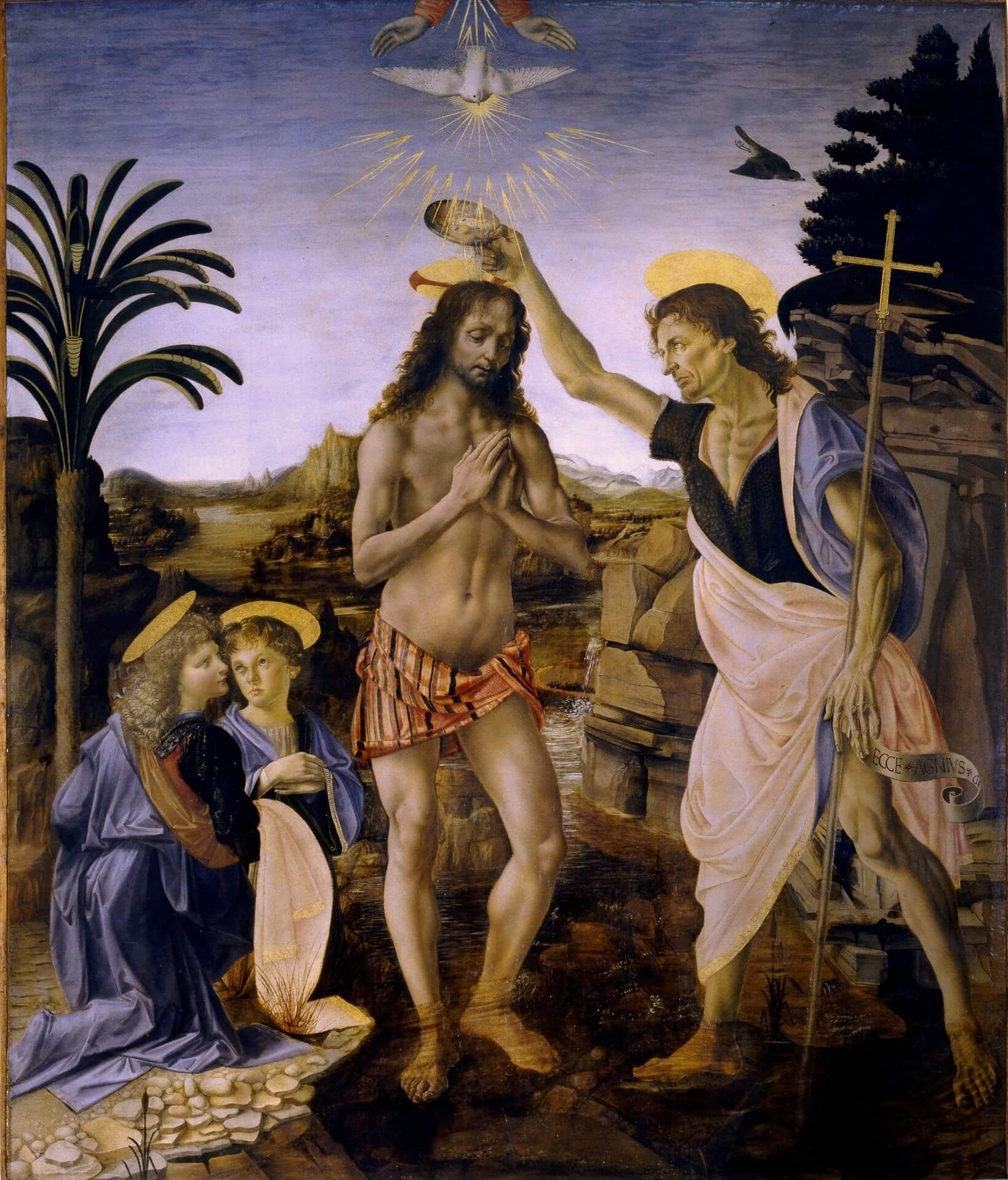 Baptism of Christ, by Leonardo DaVinci
Baptism of Christ, by Leonardo DaVinci
Advent starts on the fourth Sunday before Christmas and ends on Christmas Eve (here). Christmas begins in the evening of Christmas Eve. Like elsewhere, Epiphanytide begins on Three Kings Day in Croatia. But, that does not mark the end of Christmas. In fact for Catholics, Christmas ends officially on the Feast of the Baptism of the Lord, celebrated on the Sunday after Epiphany - Three Kings Day in Croatia (in 2022, Sunday 9 January).
Accordingly, the most traditional of Catholic houses and churches in Croatia can be seen displaying their decorations until then. Three Kings does mark the end of the '12 Days of Christmas', but this is a secular duration of Christmas and has little to do with Croatian tradition.
With grateful thanks to Iris Ćelić, family Kutleša / Marinić, Pater Ivan Dominik Ilicic and Marko Čurković
How to Make Traditional Christmas Cookies, Level: Beginner
What happens when a beginner baker attempts to make traditional Christmas cookies? A lighthearted personal blog to document a slightly chaotic evening of holiday baking
Christmas snuck up on me this year. It’s the first holiday season in four years that I’m spending with my family, and I couldn’t be more overjoyed - looking forward to our traditional chaos of decorating the tree on Christmas Eve and gobbling up bakalar like there’s no tomorrow. I even managed to buy most presents on time, but there’s one thing I forgot: Christmas cookies!
Save for helping my mom with holiday baking while I was growing up, I’ve never really tried my hand at making my own Christmas (or any other) cookies. I’m sure this comes easy to a lot of people, but I shy away from working with any kind of dough (especially if yeast is involved - rest assured I did not partake in the bread-baking obsession at the start of the pandemic). This Christmas, however, I’ve been feeling ambitious and picked a few recipes to try out. I was even sensible enough to stock up on all the ingredients I’d need.
And then I forgot to plan for the actual baking part. The holiday schedule got hectic as it tends to do, and last night I realised Christmas is a few days away and I’d have no time for any baking shenanigans after the 22nd… So I thought to myself, let’s just make one kind of cookie. One, and I’d consider this holiday season a success. My amazing mom’s going rampant with holiday baking as usual so we won’t be facing a shortage of sweets any time soon - here’s her baking list for the next two days, featuring a few Croatian holiday hits:
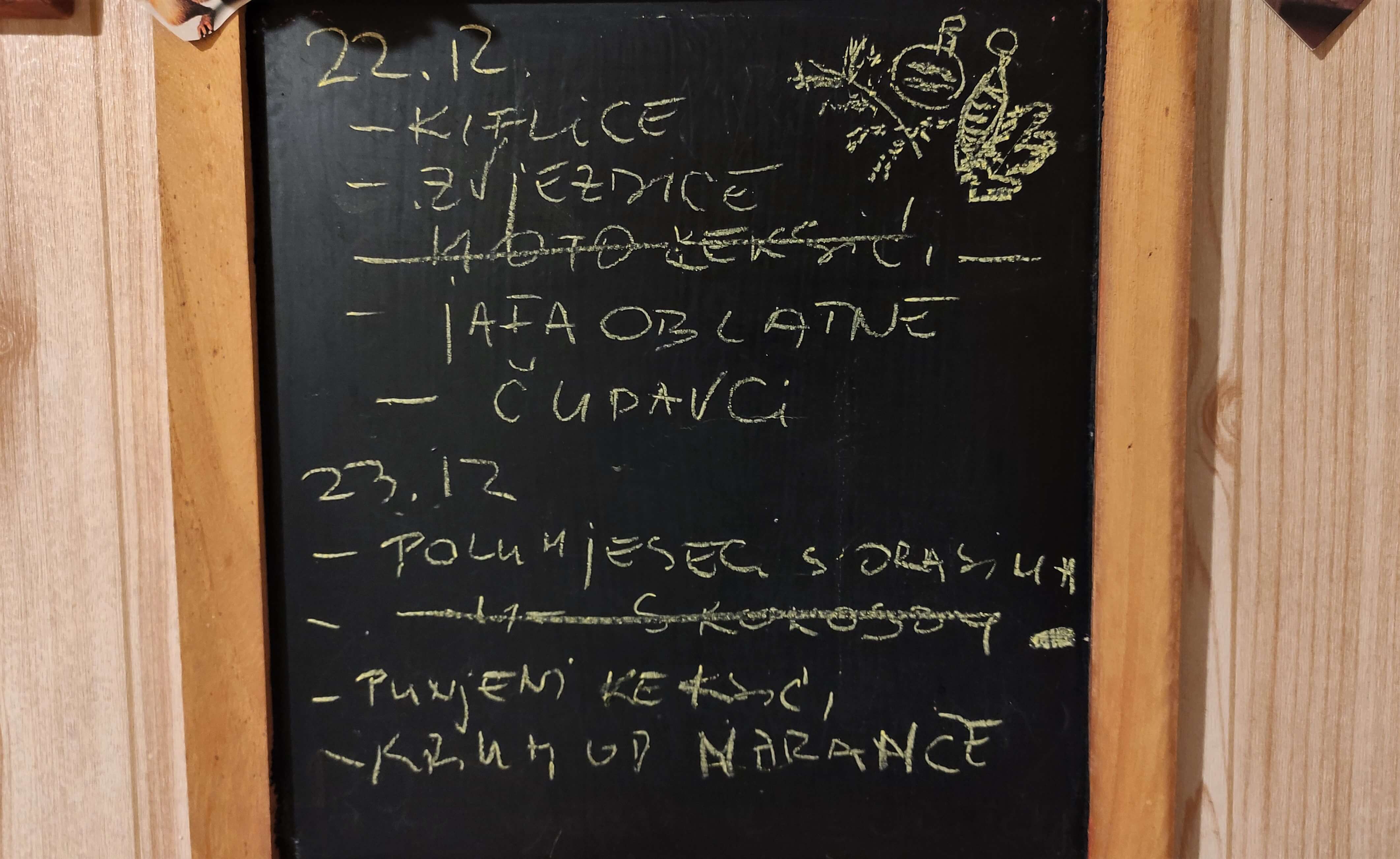
Are the crossed out ones those you’ve already made? I asked.
Nope, those are the ones I’ve given up on, she said.
Still, there’ll be plenty to go around, and so I got back to the single thing on my to-do list. Should be enough to save face, if all goes well. I rolled up my sleeves and got to work - chaotic, messy work heavily relying on improvisation.
You’ve surely seen your share of dreamy food blogs with perfectly styled photos and a highly skilled baker behind the scenes. This is not one of those blogs. While I consider myself a decent home cook, I wouldn't last two hours on the set of The Great British Bake-Off… but I’m not going to let that stop me. After all, it’s the holiday spirit that matters! Join me as I (attempt to) make linzer cookies, a Christmas staple in Croatia.
Linzer are buttery sandwich cookies filled with jam of your choice. I don’t remember a holiday season without an ungodly amount of linzer cookies in our pantry. It’s one of those things that taste better the longer you let them rest, so it’s prudent to plan ahead and double or triple the recipe to make sure you don’t run out before the season is through.
Out with the ingredients: flour, sugar, baking powder, vanilla sugar, lemon zest, butter and egg.
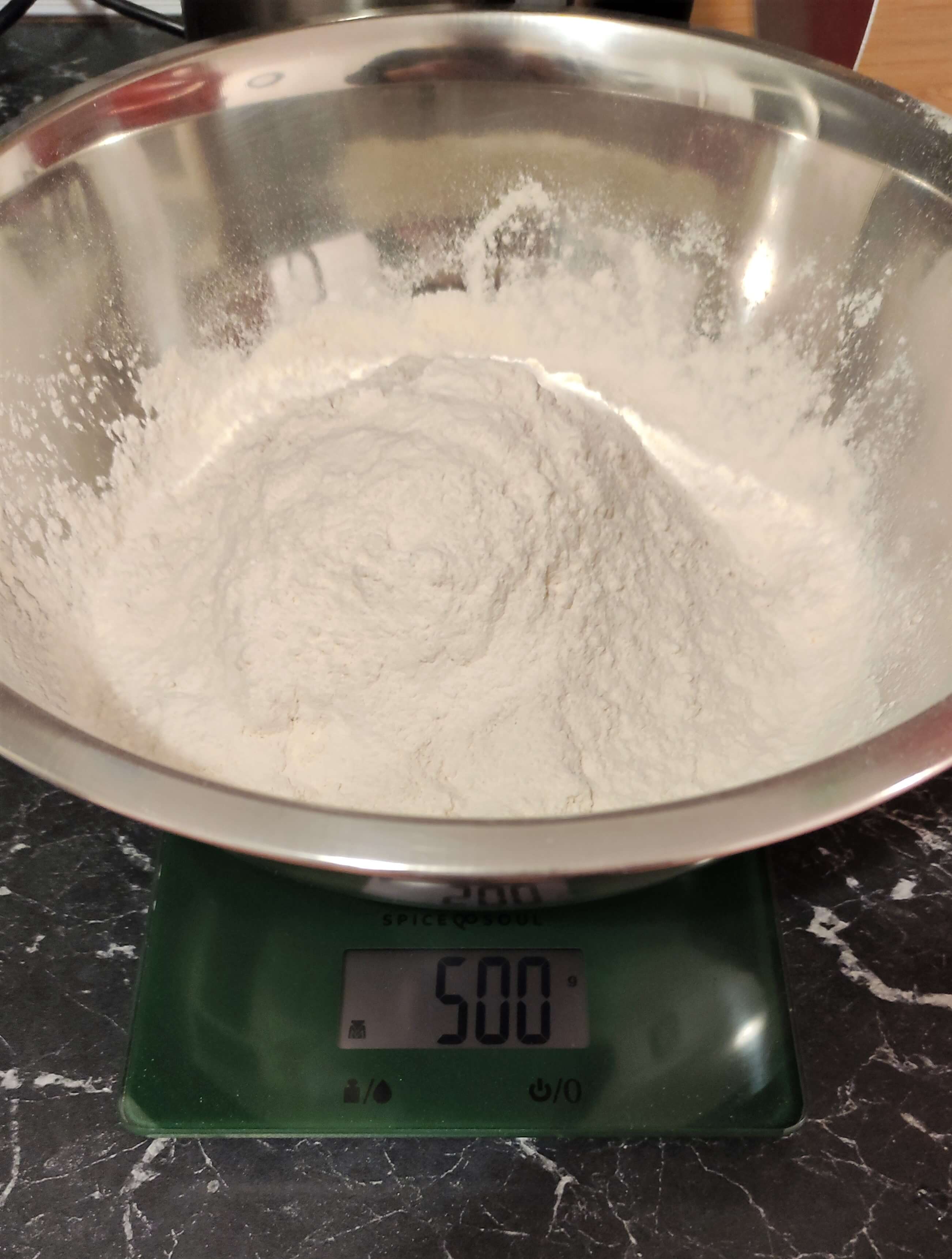
Extremely satisfying.
The recipe says to 'combine all ingredients to make a dough'. This means nothing to me. Combine them in what order? Isn’t baking a precise art? It was too late in the day to call mama for instructions, so I did some googling and found out there seemingly was no single right way to start off. Some say to cream butter and sugar with a mixer until fluffy and then add the other ingredients, some opt to combine the dry ones first and then cut in the butter.
At past 11pm, I don’t think my neighbours would enjoy the first option, so I skipped the mixer. In with the butter! A bit of elbow grease later, what wasn’t looking promising at first quickly turned into nice smooth dough. We actually might be getting somewhere:
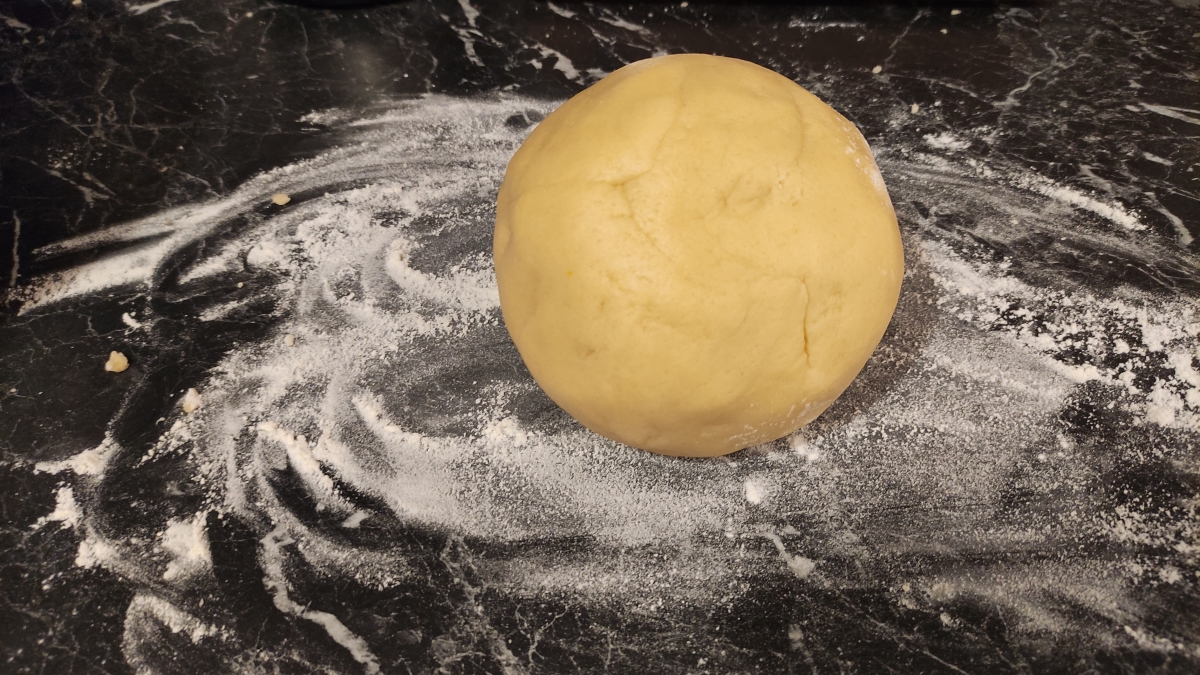
I popped the dough in the fridge to rest and went to prep the stuff I’d need for the next step. Thankfully, I recently bought a proper rolling pin - the last time I needed to roll out something, I ended up using an empty bottle of ginger ale. It was a nice glass bottle. It did the trick. I'm happy to have the rolling pin anyway.
However, I realised I'd overlooked a few crucial things in regards to the linzer project. One, I have a single baking tray, which isn’t a fun prospect knowing you’ll have at least 5-6 six trays’ worth of cookies to bake. Two, while I did pick up some festive snowflake-shaped cookie cutters, I forgot that linzer cookies feature a cutout in the top layer for the jam to peek through. Do I have anything at home to punch a hole in my cookies?
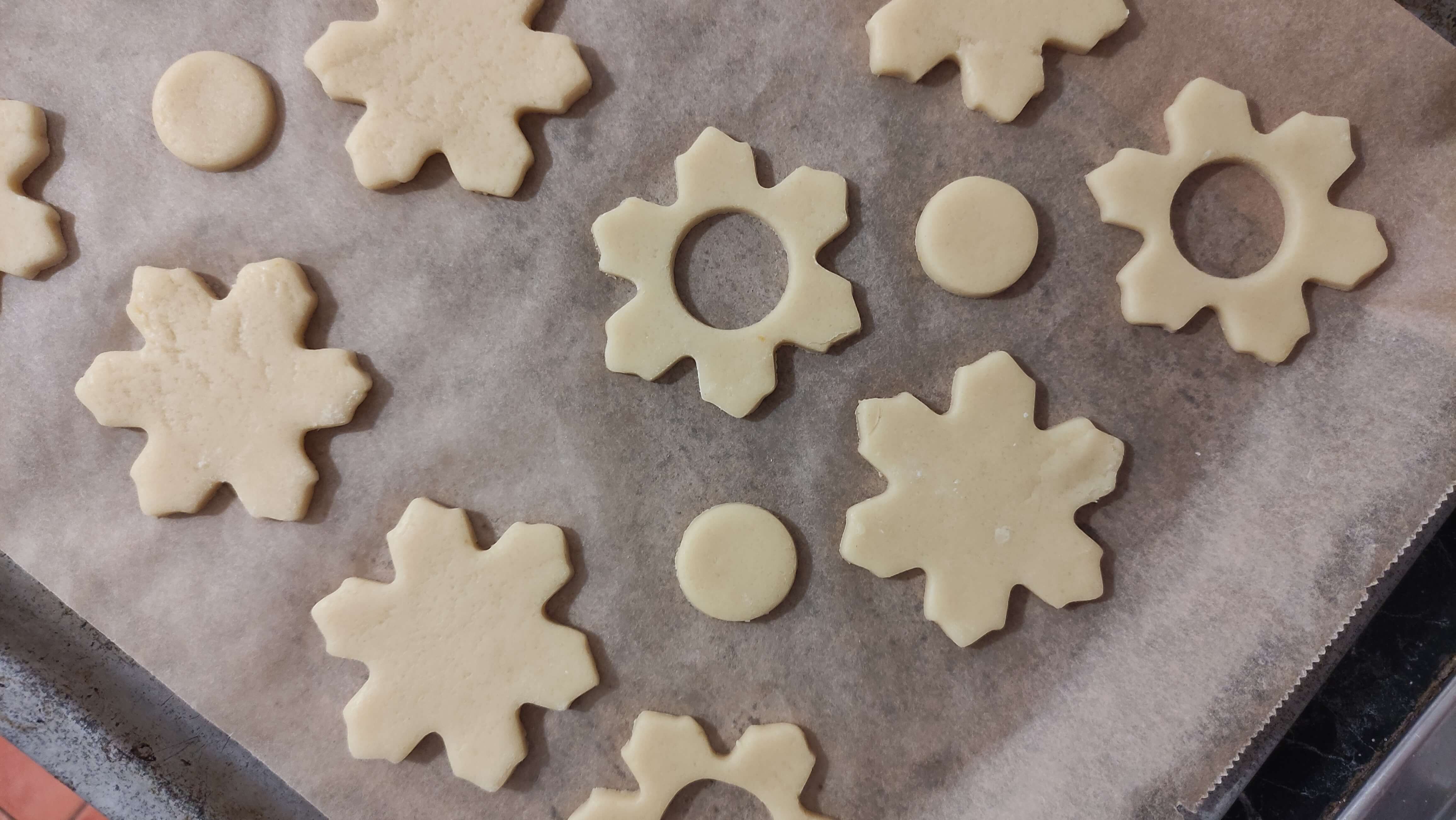
I fumbled through my kitchen drawers and found a metal tea strainer. This will do for the bigger cookies, what about the smaller ones? Too bad I don’t have a thimble, the reliable hole-punching tool that I've more often seen used in baking than sewing.
What I do have is a well stocked bar, so I snagged a tiny metal cap off of a mini bottle of Austrian schnapps. Consider this a nice homage to the Austrian origin of linzer cookies.
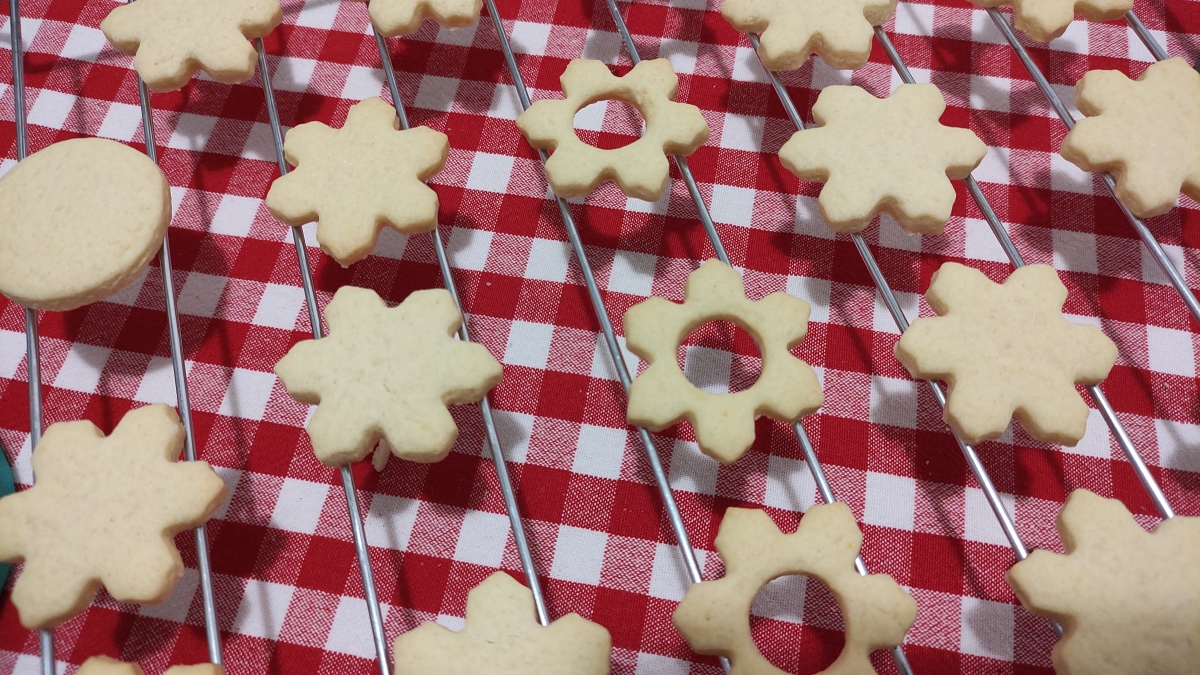
I promise these were not so ghostly pale in real life.
Not the most elegant solution, but needs must. It’s not too late to turn away, dear reader, because things only get more crafty from this point on.
The snowflake cookies turned out a bit difficult to handle due to their specific shape, and I wanted to make a batch of simple round cookies as well. You’ve guessed - no round cookie cutters in the household, but I learned a wine glass does the trick quite nicely:
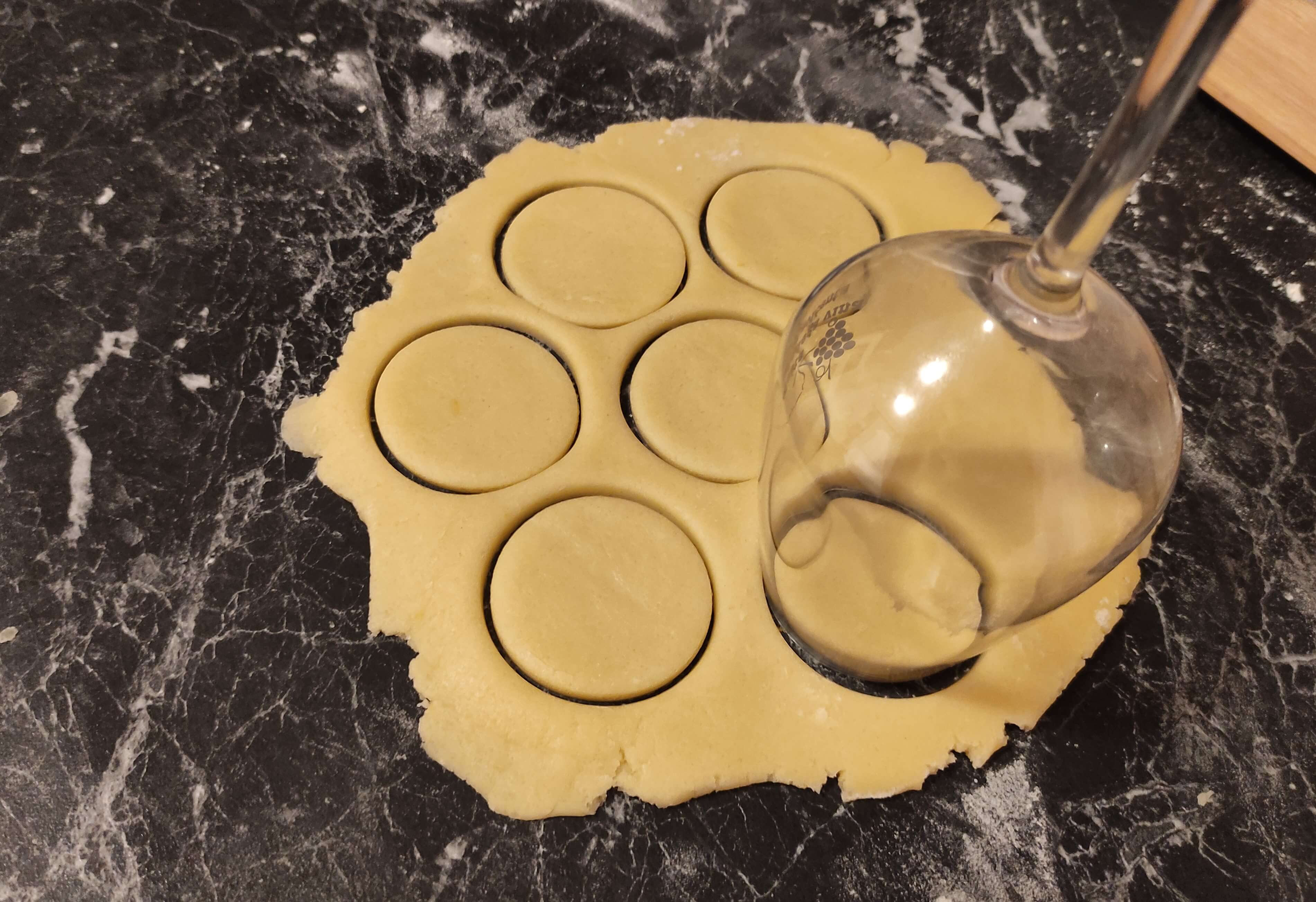
A little test run - seems to work.
At this point, it’s 1am and I’m questioning my life choices. The last batch is in the oven and I still have the final step to complete: warm up some jam on the stove and assemble the little linzer sandwiches. The jam firms up as it cools down, acting like glue that ensures the cookies stick together and stay in place.
Let’s not forget some dramatic flair, a holiday-themed reenactment of Scarface with a mountain of powdered sugar covering every inch of my kitchen counters. Luckily I remembered to generously dust the top cookies with sugar before assembly, so that the jam peeking through the cutout remains nice and glossy. It’s a lovely pop of colour that gives linzer cookies their distinctive appearance. Success!
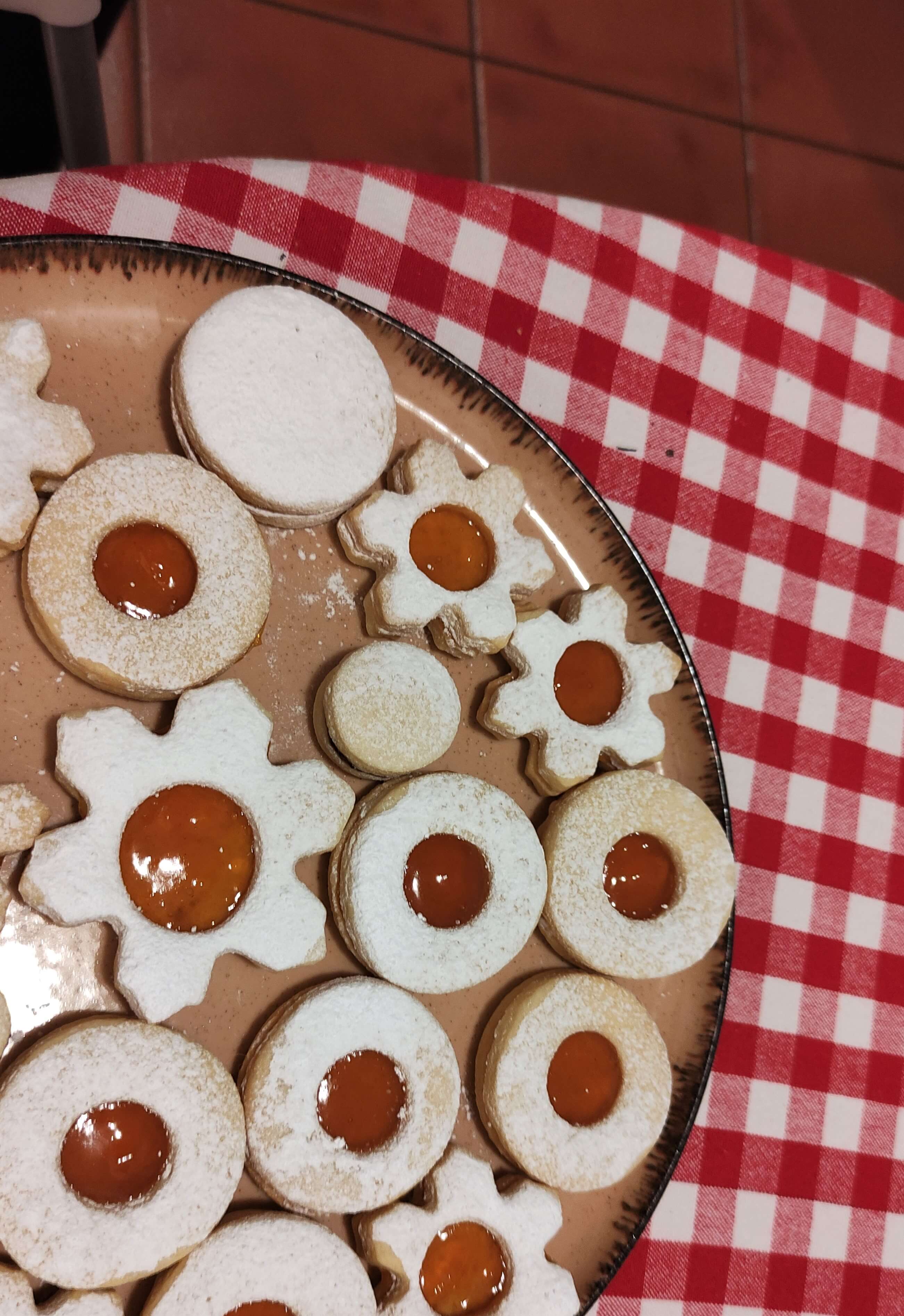
I've a talent for food photography as well.
A little uneven, but delicious - I was surprised how decent they turned out considering I MacGyvered my way through the whole affair. I have a bite to make sure they’re fine to serve to others, and I feel that unmistakable taste of the holiday season.
Oh, and a final tip. To ensure that people in your household don’t break into your stash of cookies too soon, store them where noone will think to look - in the sewing tin ;)
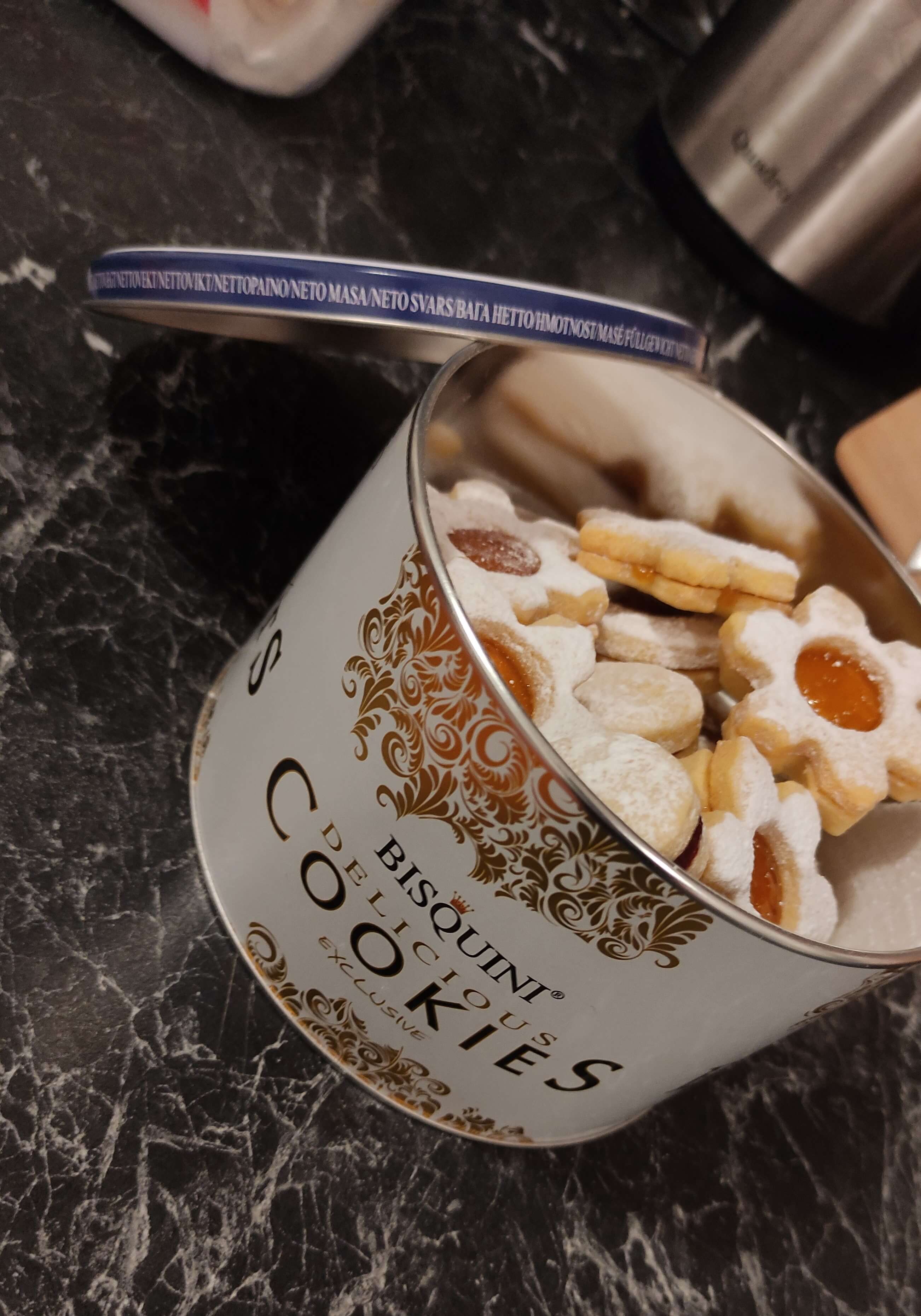
Wishing you a wonderful holiday season full of delicious treats. Happy Christmas!
Most Croatians to Spend up to HRK 500 on Christmas Gifts
ZAGREB, 17 Dec 2021 - Most Croatians plan to spend up to HRK 500 on Christmas presents, a survey carried out by Ja Trgovac magazine and the Hendal market research agency shows.
The survey, conducted in November on a representative sample of people aged above 16, revealed that 31.6 per cent of respondents would spend up to HRK 500 (€67) on Christmas gifts and 24 per cent up to HRK 200 (€27).
Nearly 21 per cent of those interviewed said they were not planning to buy any Christmas gifts this year, similar to last year when 22 per cent said the same.
This year's survey showed an increase in the number of people who would spend less on Christmas presents than last year, as 36.6 per cent of respondents said they would spend less for that purpose, compared to 33.5% in 2020.
On the other hand, the number of those planning to spend more also increased, from 3.9 per cent last year to 6.2 per cent this year. However, the proportion of the largest group, who say that they will spend the same as the previous year, fell from 62.6 per cent in 2020 to 57.0 per cent in 2021.
Around 59 per cent of respondents plan on buying Christmas gifts online, compared with 55 per cent last year.
The survey also showed that fewer and fewer people found pleasure in Christmas shopping. This year 41 per cent said they enjoyed it, down from 48 per cent last year.
The proportion of people who find Christmas shopping stressful increased to 22 per cent, while 37 per cent said that it gave them both stress and satisfaction.
About 10 per cent of those interviewed said they were planning on going on winter holidays or skiing trips, the same as last year.
For more on lifestyle, follow TCN's dedicated page.
Festive December Holidays Fun at 2021 Christmas in Ludbreg
December 02, 2021 – From winter walks and cycling to festive lights, farmers markets and the arrival of Saint Nicholas, there's a full calendar of activity and fun at Christmas in Ludbreg
Sitting just an hour's drive northeast of the Croatian capital, the town of Ludbreg is easily among one of the most appealing day trips you can take from Zagreb. And, no more true is that than in the December holiday season.
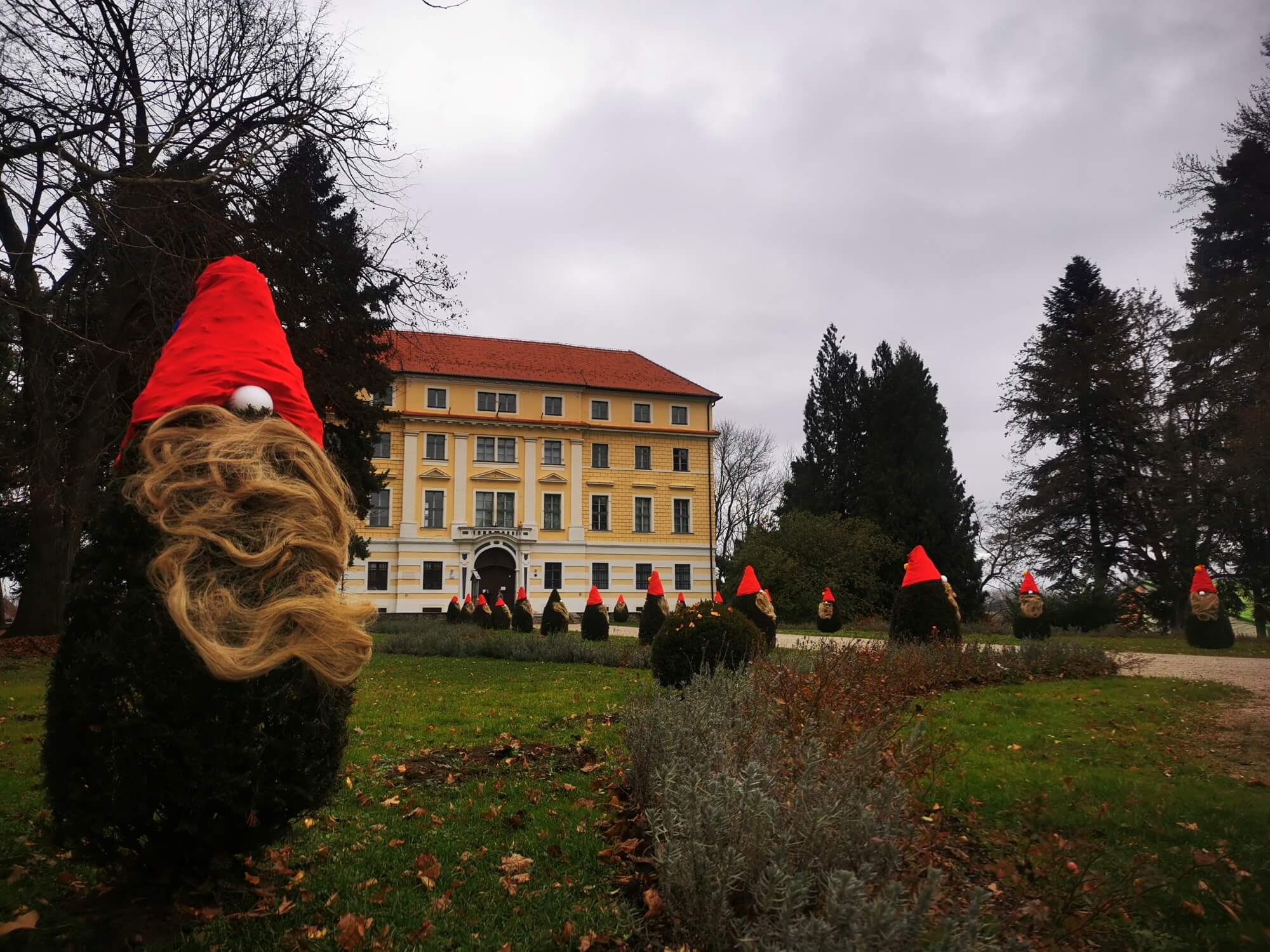 Batthyany castle, Ludbreg, December 2021 © Nikolina Breber
Batthyany castle, Ludbreg, December 2021 © Nikolina Breber
The fields and hills surrounding Ludbreg are today still home to traditional agriculture and winemaking. In the winter season, the families of these farms and vineyards bring the best produce to sell in town. Sparkling with Christmas lights and with seasonal music events adding to the atmosphere, Ludbreg is a great place to pick up a Christmas gift.
But, the nature surrounding the town is not only loved for its produce. Winter and Christmas in Ludbreg is a great time for active events and keeping fit. You can here challenge yourself on a cross country trek or bike race this season.
There are events at Christmas in Ludbreg for everyone. From the youngest family members and their teenage siblings to mom, dad and grandparents too. Here's a look at December's seasonal calendar for Christmas in Ludbreg.
St. Nicholas Day - 5 December - Ciklokros League Ludbreg
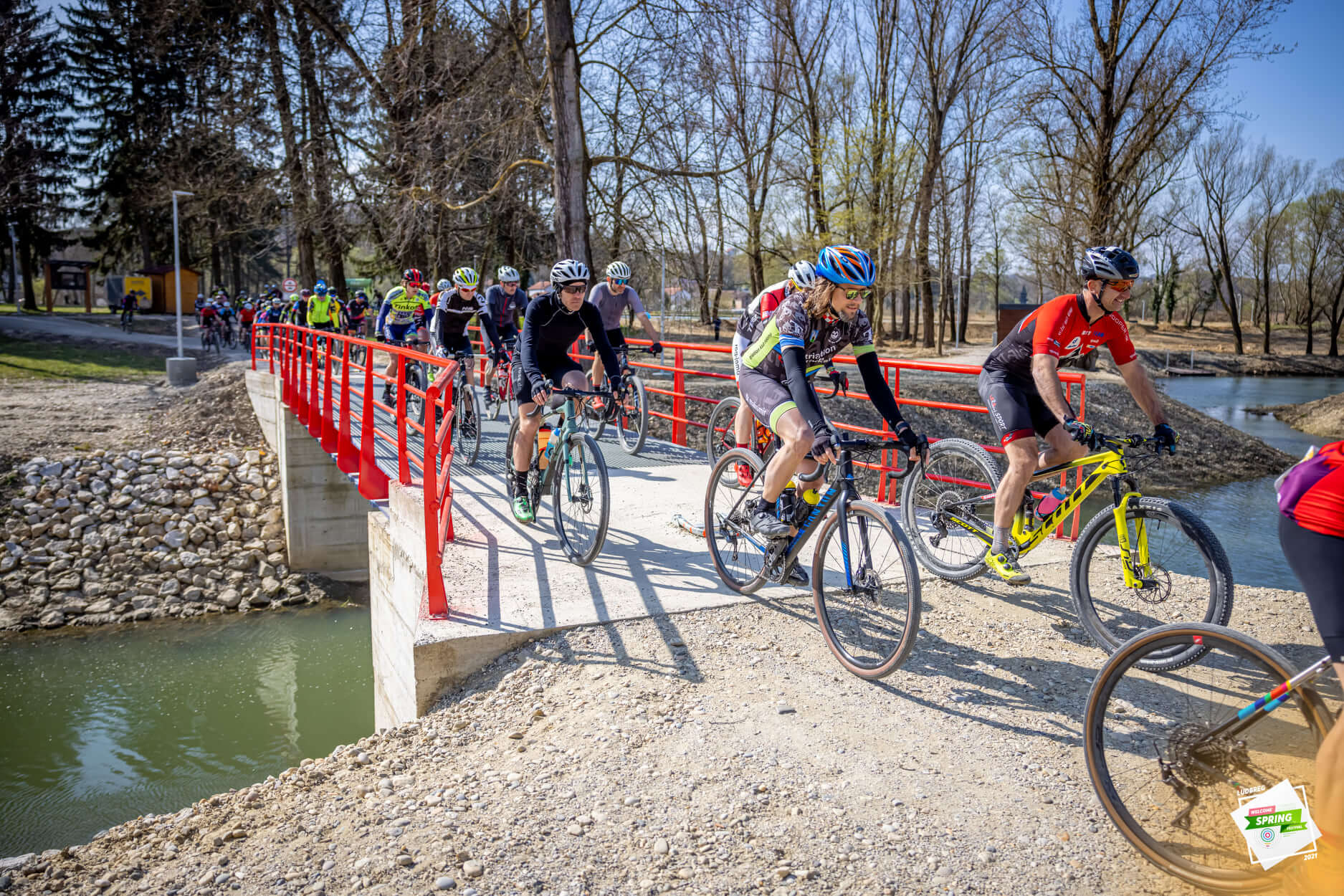 © Ciklokros
© Ciklokros
Following a successful tour in spring, the second round of 2021's Ciklokros League is here. This time, it's a series of seven Sunday races that journey through the stunning Autumn/Winter landscapes of northwest Croatia. And, on 5th December, it's the Ludbreg race.
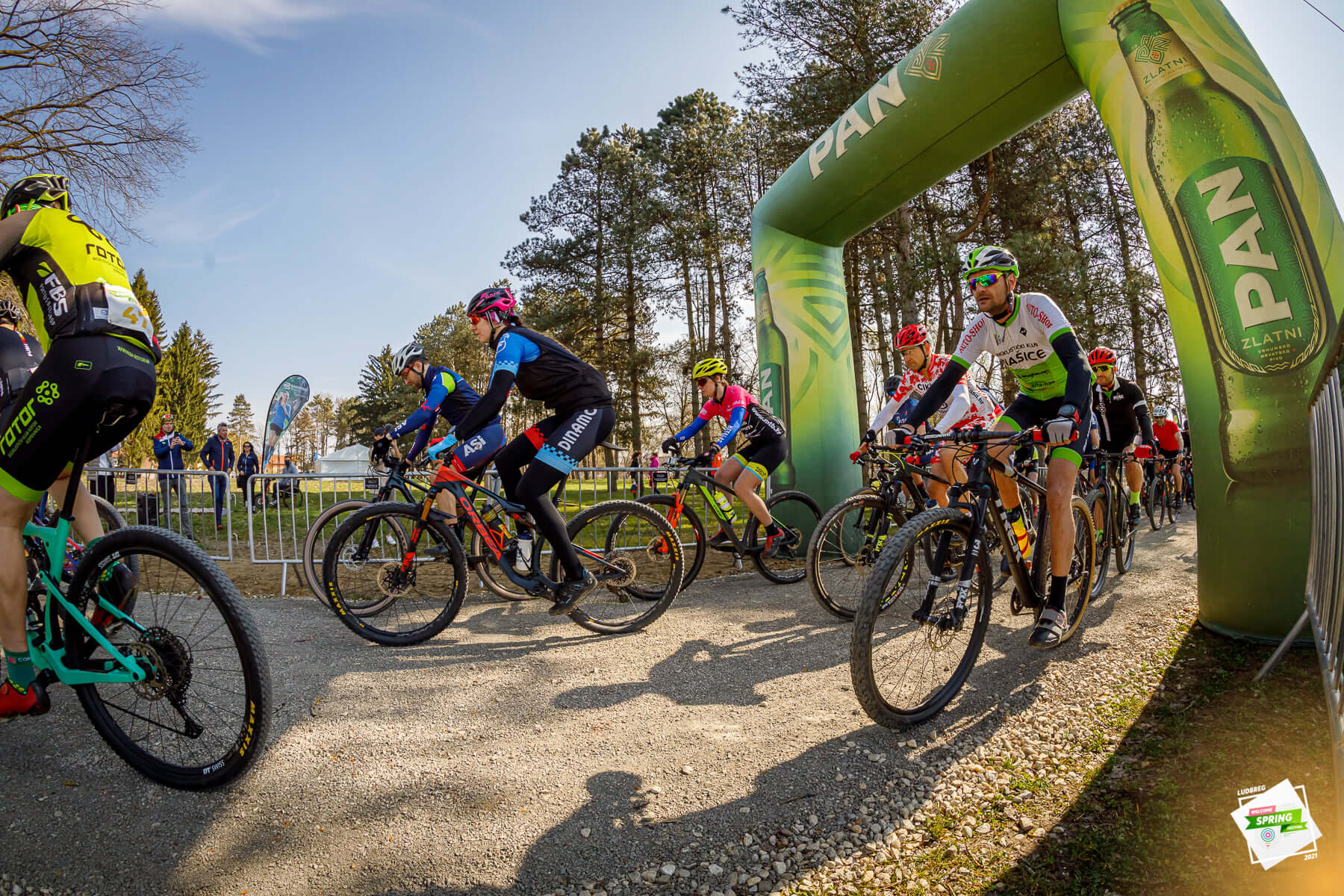 © Ciklokros
© Ciklokros
Cyclists will race successive laps of a 2000 metre course past the waters, lawns and trees of Ludbreg's Otok Mladosti. The fun trail is a mixture of dirt track, grass and course gravel path, unchallenging and perfect for any kind of bmx, mountain bike or cross country racer (more fragile, traditional road racing bikes perhaps wouldn't be so suitable and electric bikes are not permitted). Although keep an eye out – race organisers have placed some obstacles on the route for you to go around.
The event welcomes competitors all ages and abilities, with an initial race starting at 1pm and the second at 1.20pm. You can get more info here and apply to take part here, with the entry fee being just 50 kuna.
St. Nicholas Day - 6 December - Arrival of Saint Nicholas by Horse Drawn Carriage
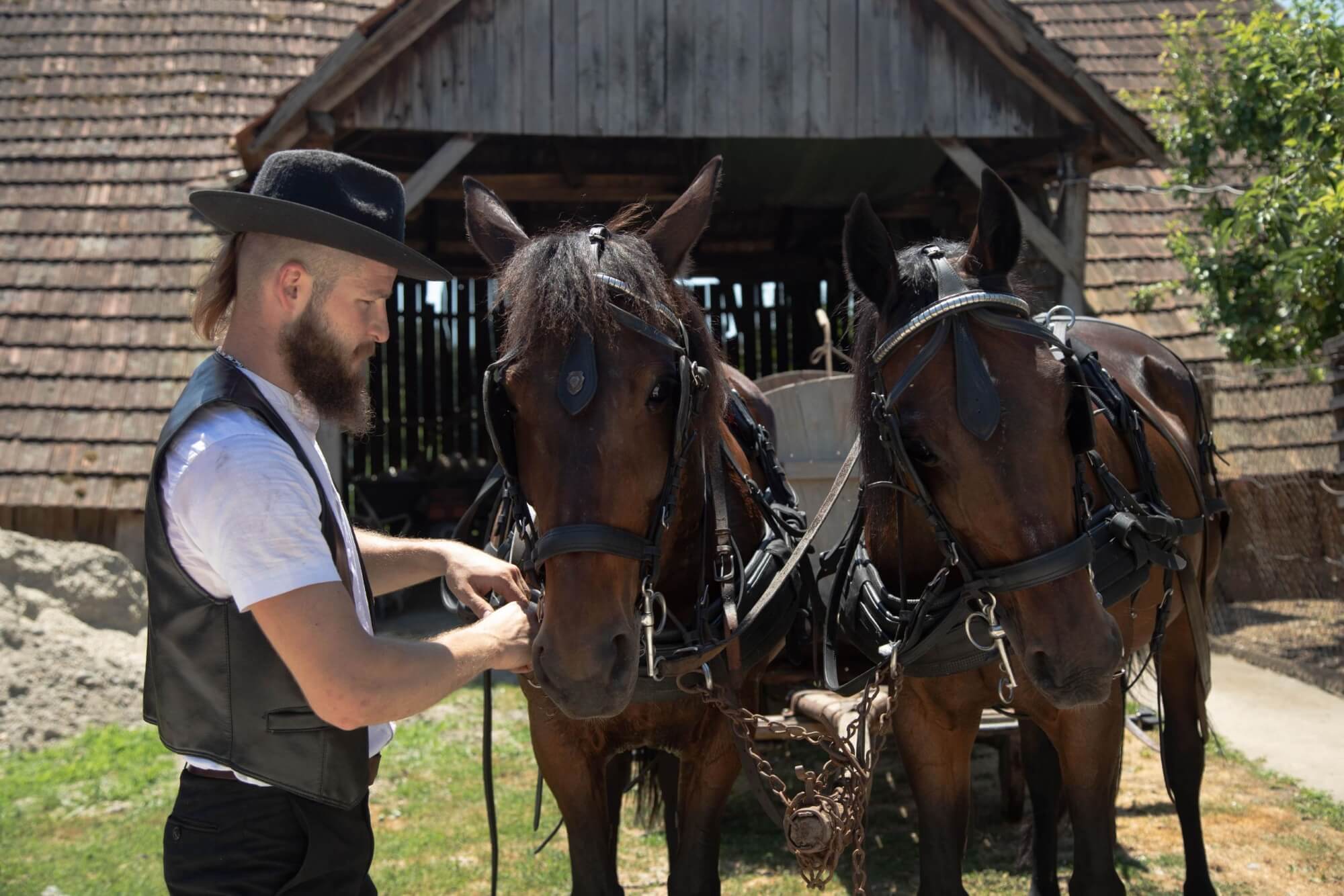 © Matea Maltarić
© Matea Maltarić
Many children have to wait until Christmas Eve for a visit from Santa Claus. But, not the youngsters of Ludbreg. In Croatia, the celebration of Saint Nicholas Day is still observed traditionally on December 5/6th. Often, it's a time of gift-giving. Always, it's a time loved by the young people of Ludbreg.
Of course, Santa usually arrives on a sleigh pulled by reindeer. But, there's simply no guarantee of the necessary snow so early in winter. So, in Ludbreg, Saint Nicholas arrives by horse-drawn carriage. Horses are a much-loved feature of sporting and social events in Ludbreg, with the town's summertime equestrian games now being a decade old.
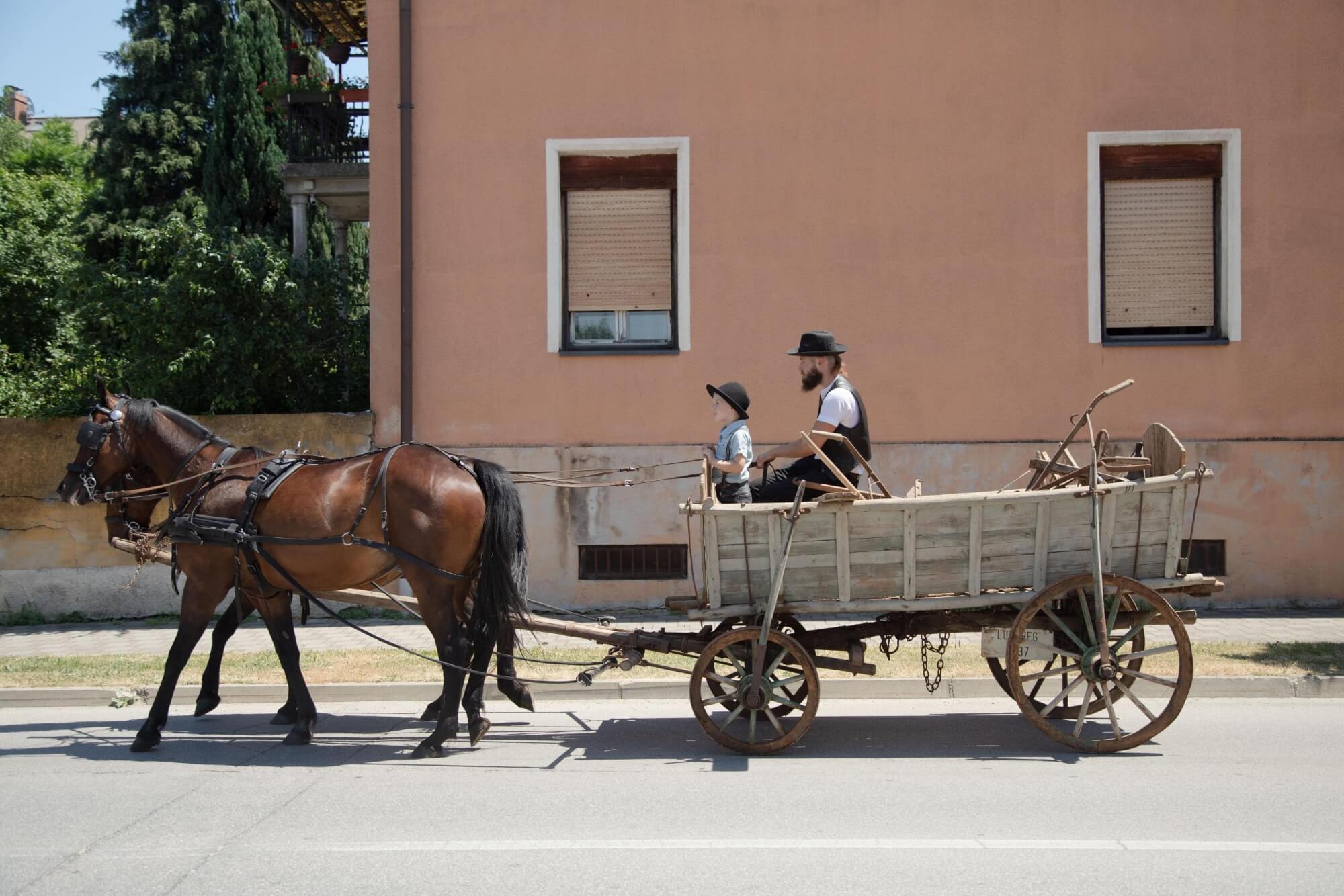 © Matea Maltarić
© Matea Maltarić
Because it's his day, Saint Nicholas gets the first ride with the horses. But, after he arrives to greet everyone, his carriage and horses will take youngsters for a ride around Ludbreg. Children and families can arrange horse riding or a tour in a horse-drawn carriage around Ludbreg throughout the year.
Ivana Galić concert at Batthyany castle - 17 December
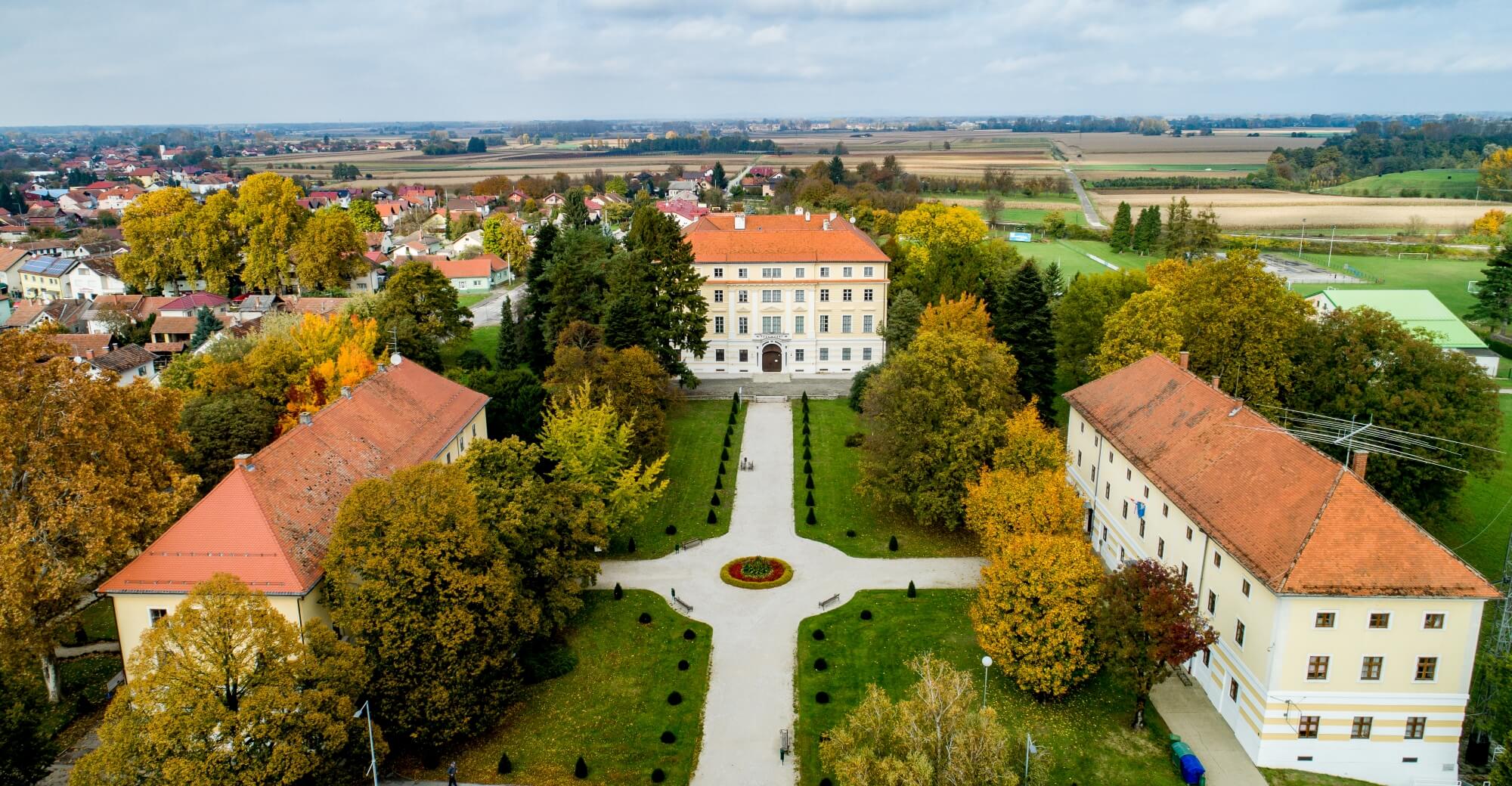 Batthyany castle, one of the venues for Christmas in Ludbreg © Siniša Sović
Batthyany castle, one of the venues for Christmas in Ludbreg © Siniša Sović
Despite her young years, singer Ivana Galić already has a performance career that stretches back some 20 years. She has appeared as part of choirs and ensembles and as a soloist at concerts across Europe. In her native Croatia, she is particularly well known for the vocals she lends to black music genres – jazz, soul and gospel. Indeed, she has performed in the UK as a guest of the renowned Birmingham Community Gospel Choir. It is to this gospel genre that Ivana Galić and her quartet return at this special Yuletide concert.
The venue for the concert is Batthyany castle. The focal point of Ludbreg Old Town, the castle today is a fully refurbished version of the opulent residence fashioned here in the 18th century (although, the original castle that stood on this spot is significantly older). What more spectacular setting could you ask for this special seasonal concert? The concert starts at 6pm.
Advent at Christmas in Ludbreg - 19 December
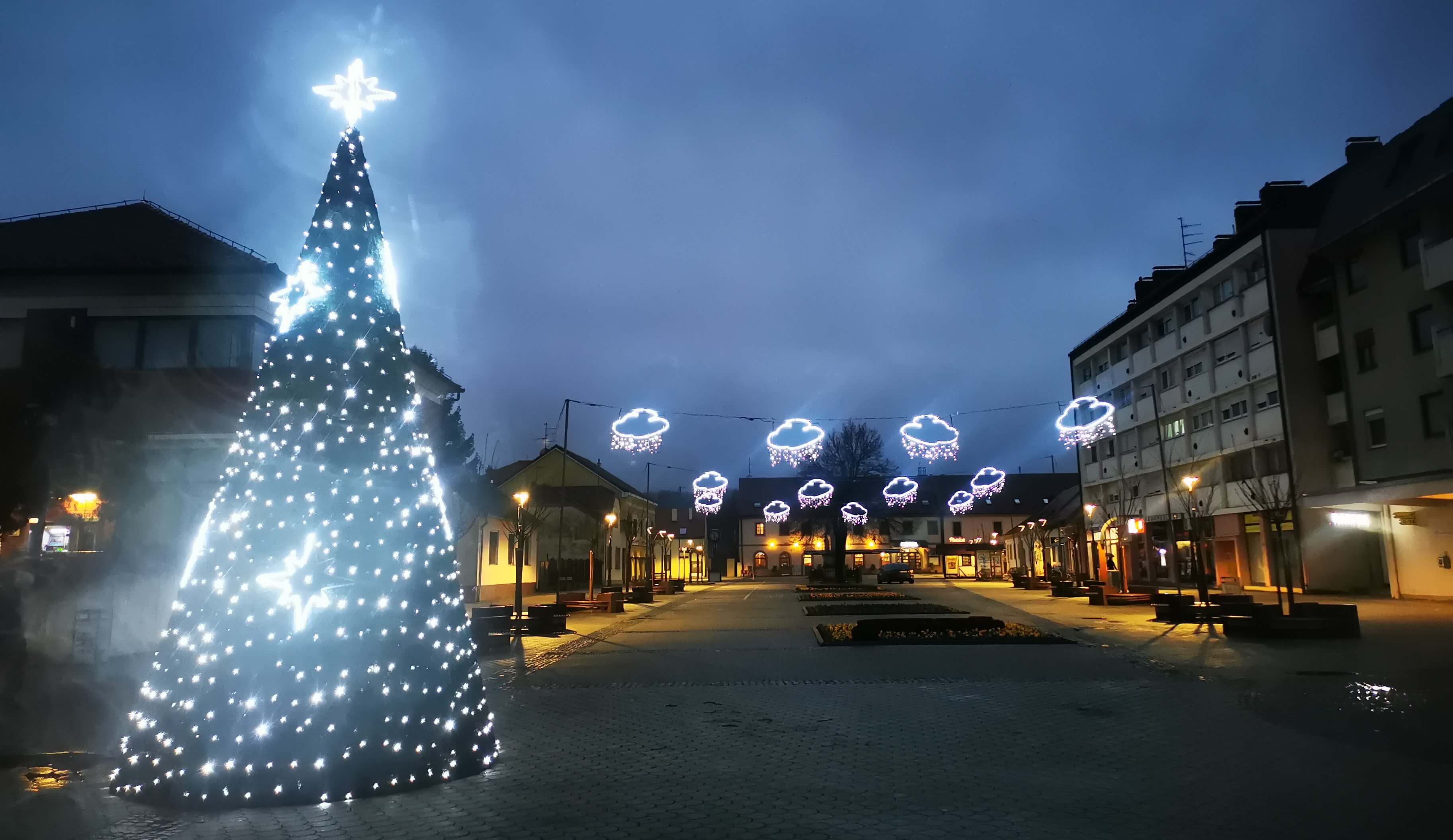 Christmas in Ludbreg 2021 © Nikolina Breber
Christmas in Ludbreg 2021 © Nikolina Breber
Ludbreg is a wonderful town to visit at any time of year. But, during Advent, Ludbreg is particularly quaint and romantic. The town is dressed in flickering, seasonal lights and nowhere is the seasonal spirit better felt than on the parade of huts and stalls of the Christmas market.
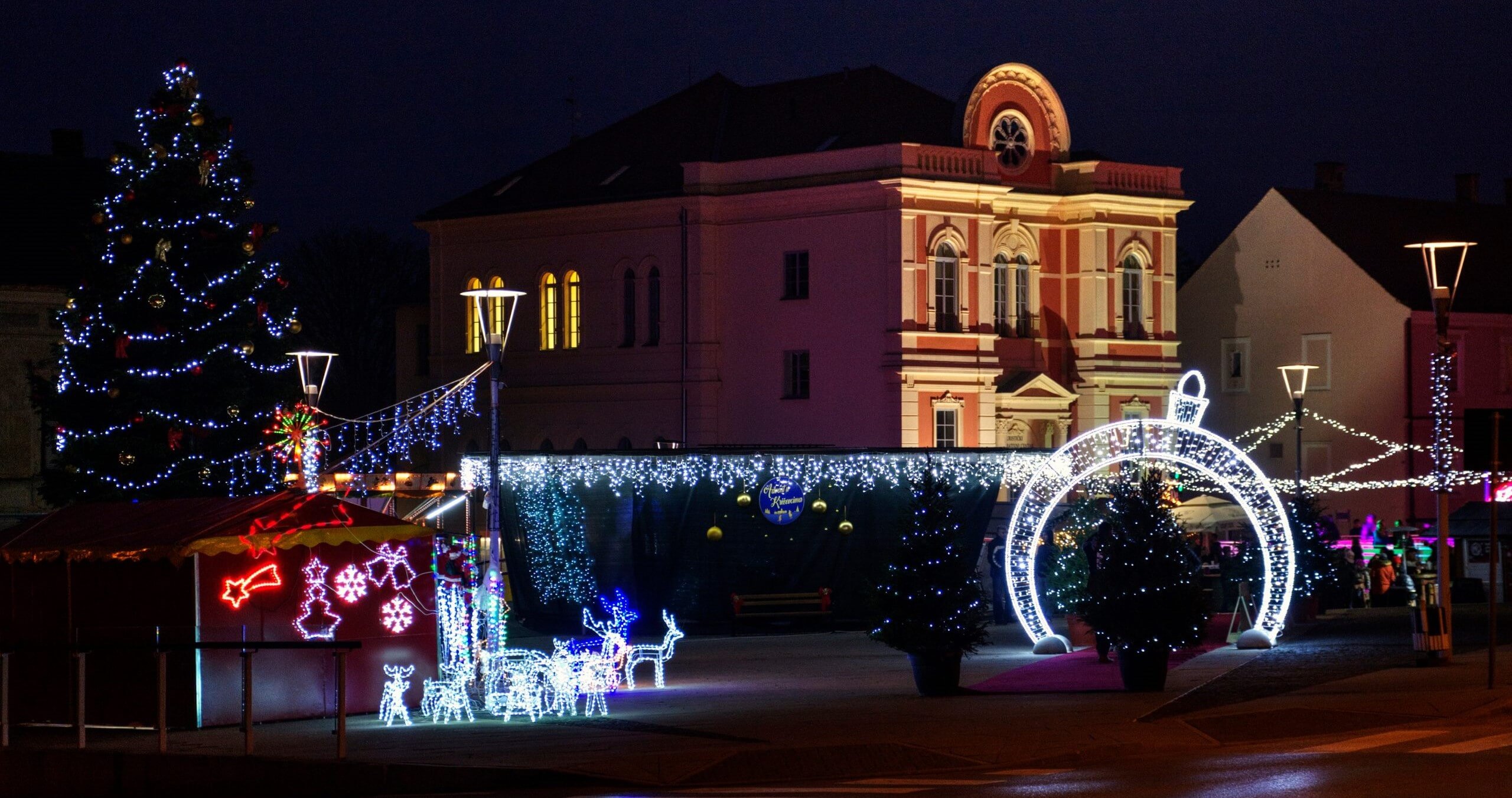 Christmas in Ludbreg © Visit Ludbreg
Christmas in Ludbreg © Visit Ludbreg
This year, scents and flavours of the Christmas season will waft through the Ludbreg air on Sunday 19 December. On the occasion, folks from the surrounding family farms will come to town to show off the best of their seasonal produce. Looking for some authentic, tasty or traditional gifts? This is the place to come.
The Christmas market will start at 13.00 and run until 20.00. In 2021, it takes place in the newly renovated Zanatski trg (Craft square) and on the promenade.
Crazy Hill Trekk 2021 - 19 December
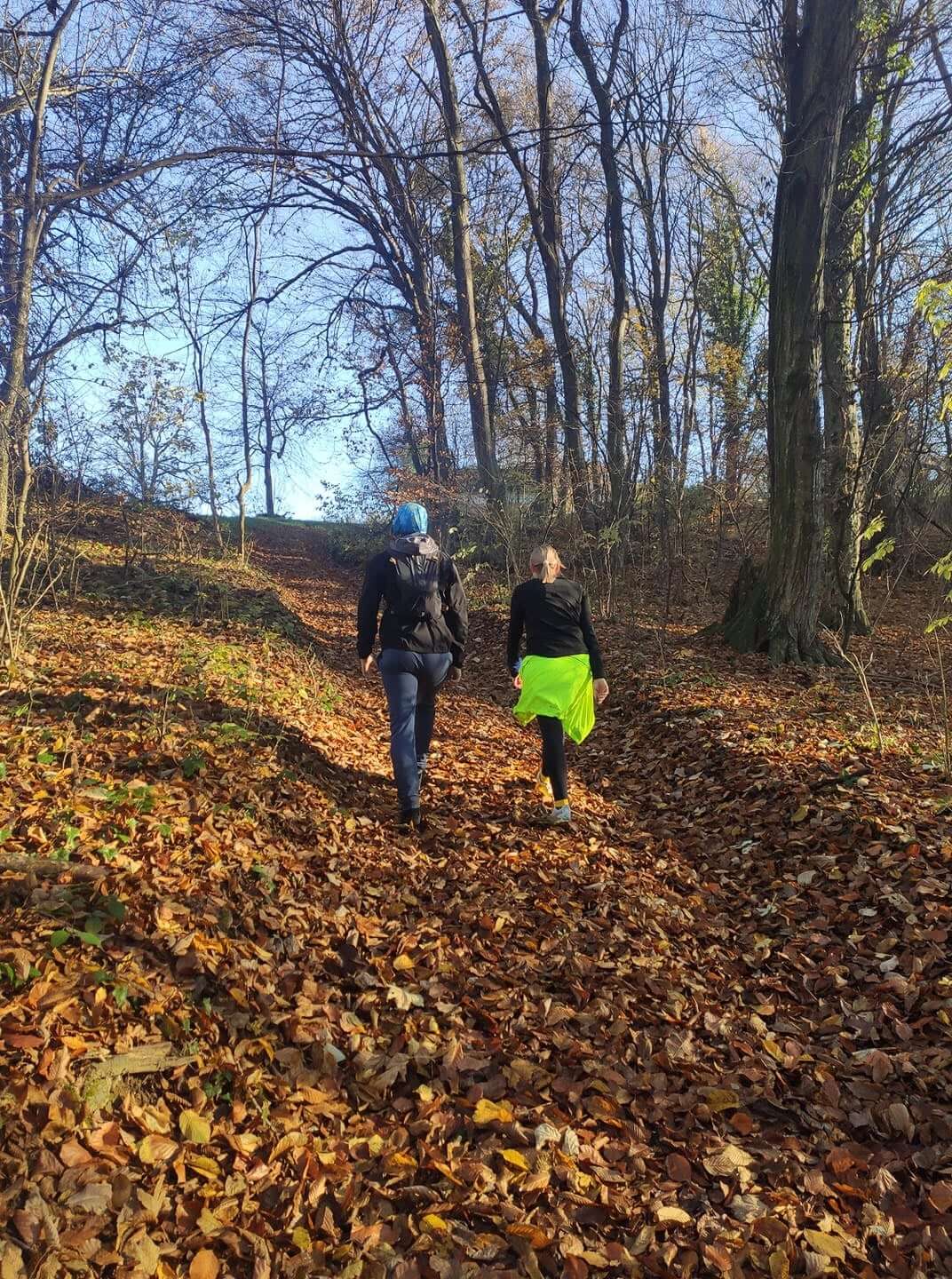 © ŠRD BSV Ludbreg
© ŠRD BSV Ludbreg
Some will wait until January before trying to shift the extra kilograms you gain eating rich Christmas food. Not in Ludbreg, where folks balance fine living with a healthy lifestyle. The cooler winter temperatures are perfect for a little exercise and exertion. That's exactly what you'll get at the second annual Crazy Hill Trekk.
 © ŠRD BSV Ludbreg
© ŠRD BSV Ludbreg
This orienteering trek race will take you through the magical hills and forests that lie on the outskirts of Ludbreg - Vinogradi Ludbreški and Kalničko gorje. As the name suggests, the terrain around Vinogradi Ludbreški is a pretty landscape filled with neat rows of grapevines. Just to the south of Ludbreg a more rugged topography begins to emerge. The peaks of the Kalnik mountains form a natural border between the historic Croatian regions of Zagorje, Prigorje and Podravina. To their west is Zagreb County, to the south and east is Koprivnica- Križevci County and to their north is Varaždin County and Ludbreg. This is an incredible setting for a wintertime expedition.
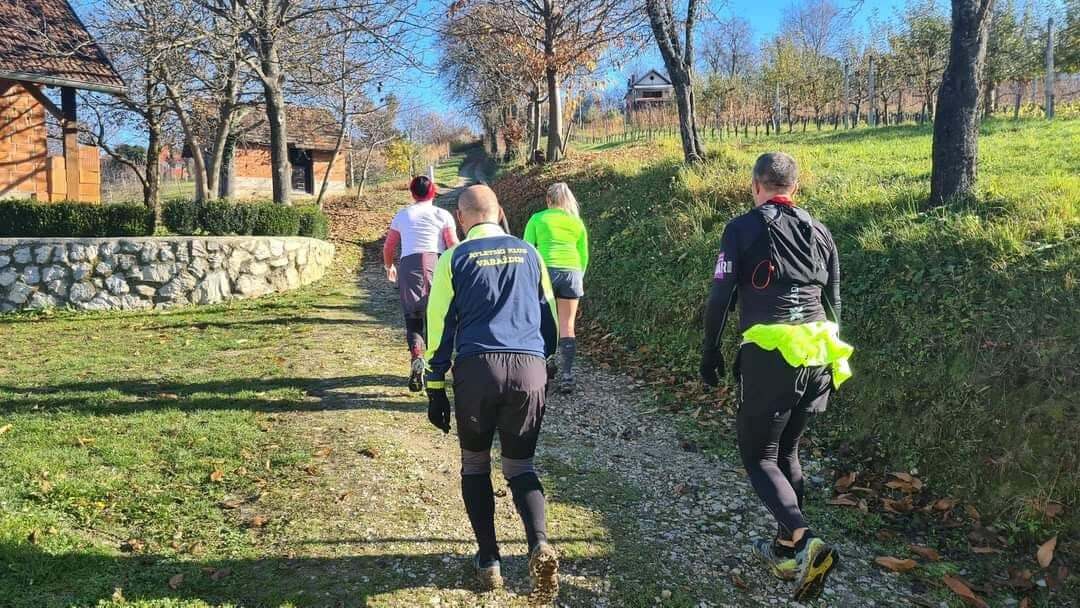 © ŠRD BSV Ludbreg
© ŠRD BSV Ludbreg
The trek welcomes entrants of all abilities and experience. For trekkers who are more prepared and more experienced, there's the 18-20km trail, with a slightly more demanding orientation aspect. For lighter runners and those simply looking for some fun recreation in a fantastic winter setting, there's a 8-10km trail. The former should take much less than the maximum 6 hours set as a time limit, with an equally generous 4 hours set for the latter.
You can find out more about the trek races and apply to enter via here.
Ministry of Agriculture Calls for Less Food Waste During Holidays
ZAGREB, Dec 28, 2020 - The Ministry of Agriculture on Monday appealed to citizens to try and reduce the amount of food thrown out during the Christmas and New Year holidays.
The festive season is a time of giving and plenty when we prepare and consume a great amount of food and drink, the ministry underscored, noting that rarely do people eat everything they bought and prepared.
Surveys have shown that about 53%, or even up to 70% according to some surveys, of food thrown out comes from households, the ministry said in a press release.
The ministry hence recalled that it had launched a series of activities during the year aimed at raising awareness among consumers regarding the problem of excessive food waste in Croatia, with the purpose of changing habits and behaviour with food in households, the workplace, in schools, in stores or in restaurants.
The ministry appealed to citizens to try and reduce the amount of food wasted in each household during the festive season by applying a series of pointers, such as planning shopping lists and rational buying without creating unnecessary stores.
"Let's be socially sensitive throughout the year and share groceries and surplus food with those in need," the ministry underlined.
The ministry recalled that reducing the amount of food waste means decreasing household costs and that contributes to a personal feeling of satisfaction because food is not being thrown away.
The ministry called on citizens to participate in trying to achieve the goal of halving the amount of food wasted by 2030.
Huge Zagreb Christmas Tree Arrives in Time for Advent
November 27, 2020 – A towering Zagreb Christmas tree has been placed on Trg bana Josipa Jelačića in the heart of the Croatian capital. It's beginning to look a lot like Christmas
A towering Zagreb Christmas tree has been placed on Trg bana Josipa Jelačića. It arrives in time for the start of the Advent season, which begins officially this weekend.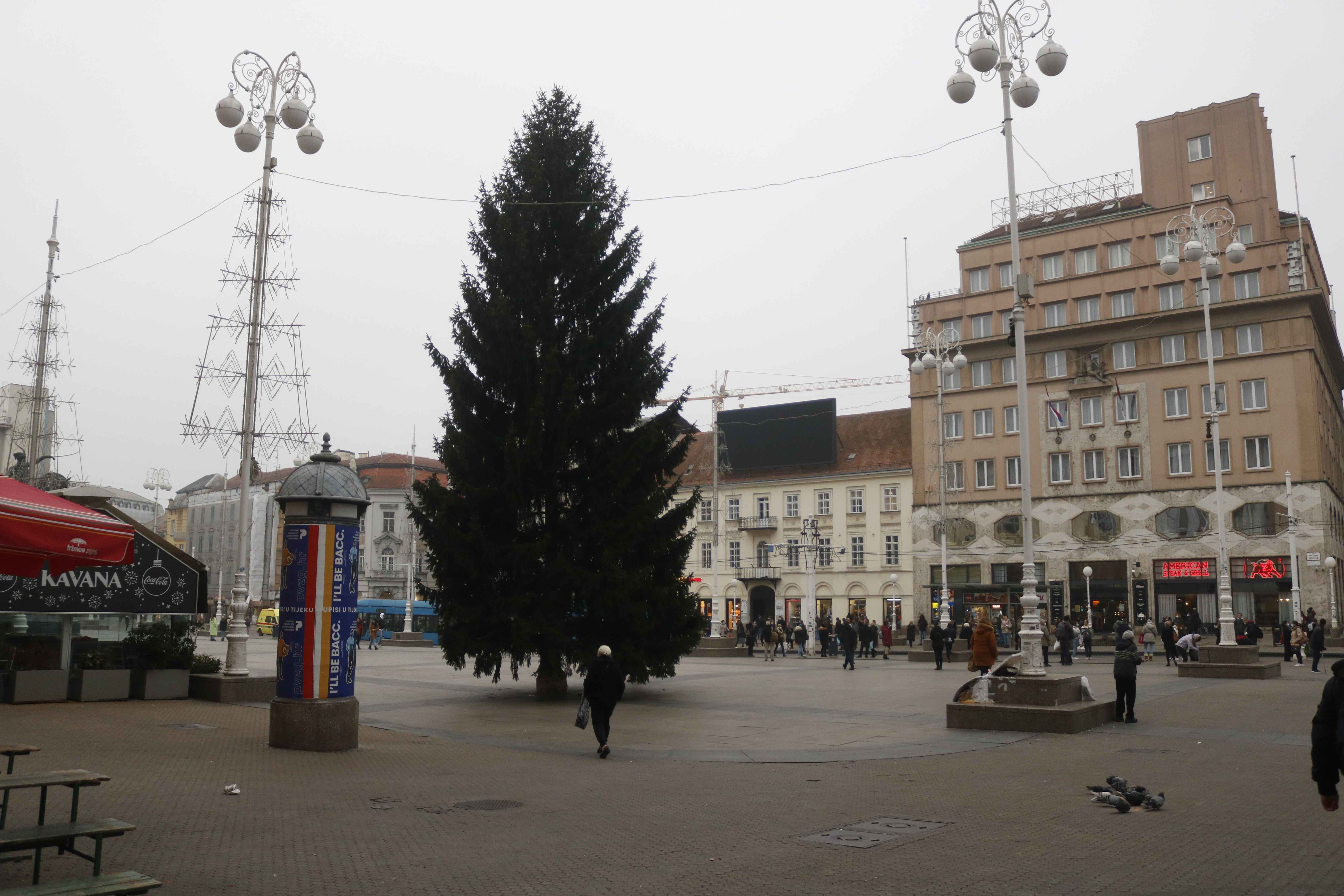
Standing between 15 metres and 20 metres in height, the Zagreb Christmas tree is so impressive it might just rival the famous statue of Josip Jelačić himself as the most eyecatching monument on the square. By the time its lights are added, we certainly wouldn't put money on Josip for the title.
A giant Christmas tree is a traditional December sight on this main square at the heart of the Croatian capital. Although it's not the only one. There are usually around 40 Christmas trees placed in public parks and squares around the city, Zagreb doesn't do Christmas half-heartedly.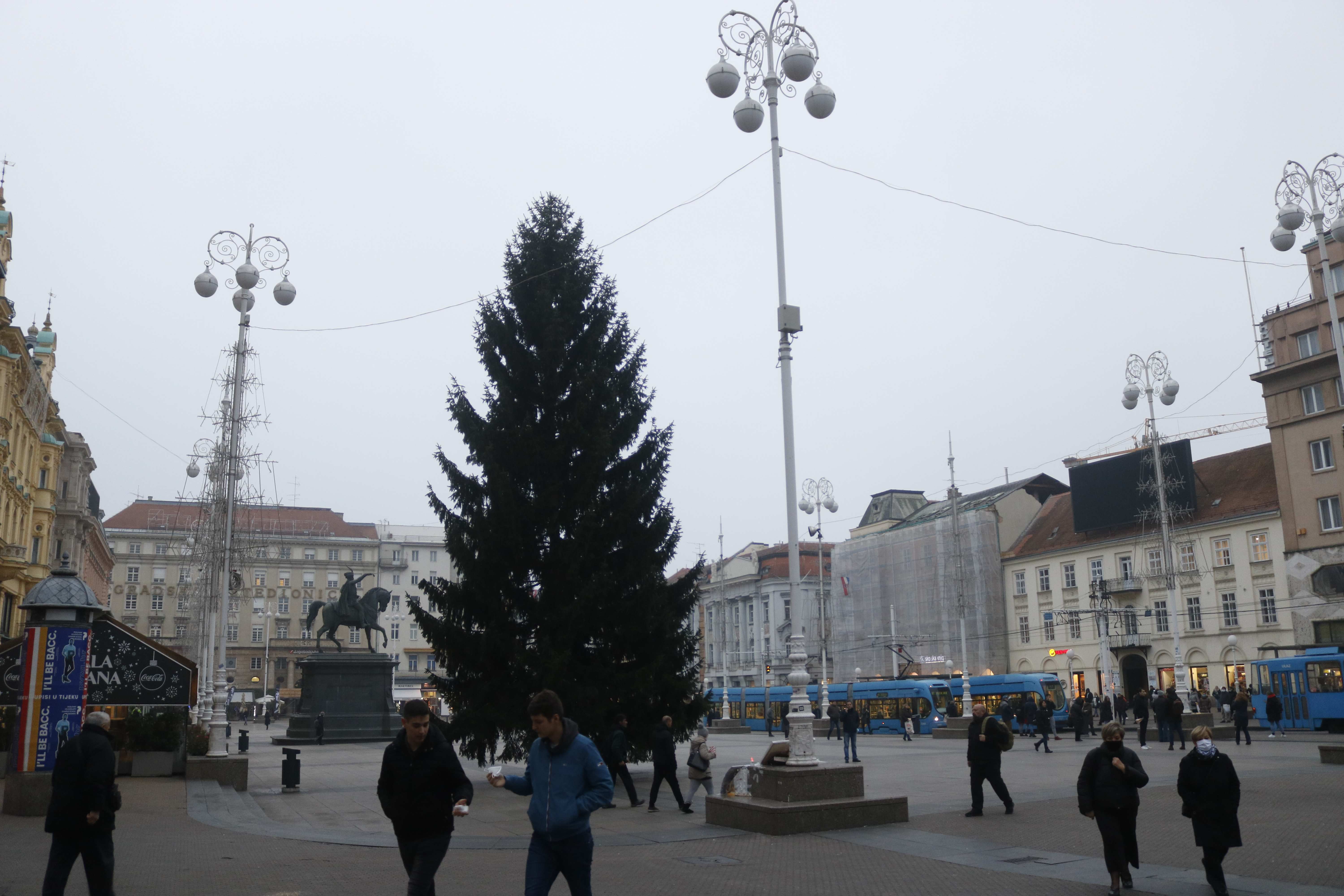
Advent celebrations in the city usually commence with the lighting of a candle by the Manduševac water feature on Trg bana Josipa Jelačića. The appearance of this first flame is the marker for the city's Christmas lights to be turned on, including those of the Zagreb Christmas tree.
We can't be sure if the Zagreb Christmas tree that now stands on Trg bana Josipa Jelačića is exactly the same one, but it does look remarkably like a giant pine tree moved from private property on Gradišćanska ulica a couple of days ago. If it is that pine, then one local resident reckons the Zagreb Christmas tree is over 35 years old. It towered above the dwelling in whose grounds it lay. Local residents were sad to see it go. But, during a year in which Zagreb has experienced its strongest earthquake in 100 years, plus hundreds of aftershocks, it's perhaps understandable why the landowners were willing to let this giant go. Two younger pine trees remain on the plot.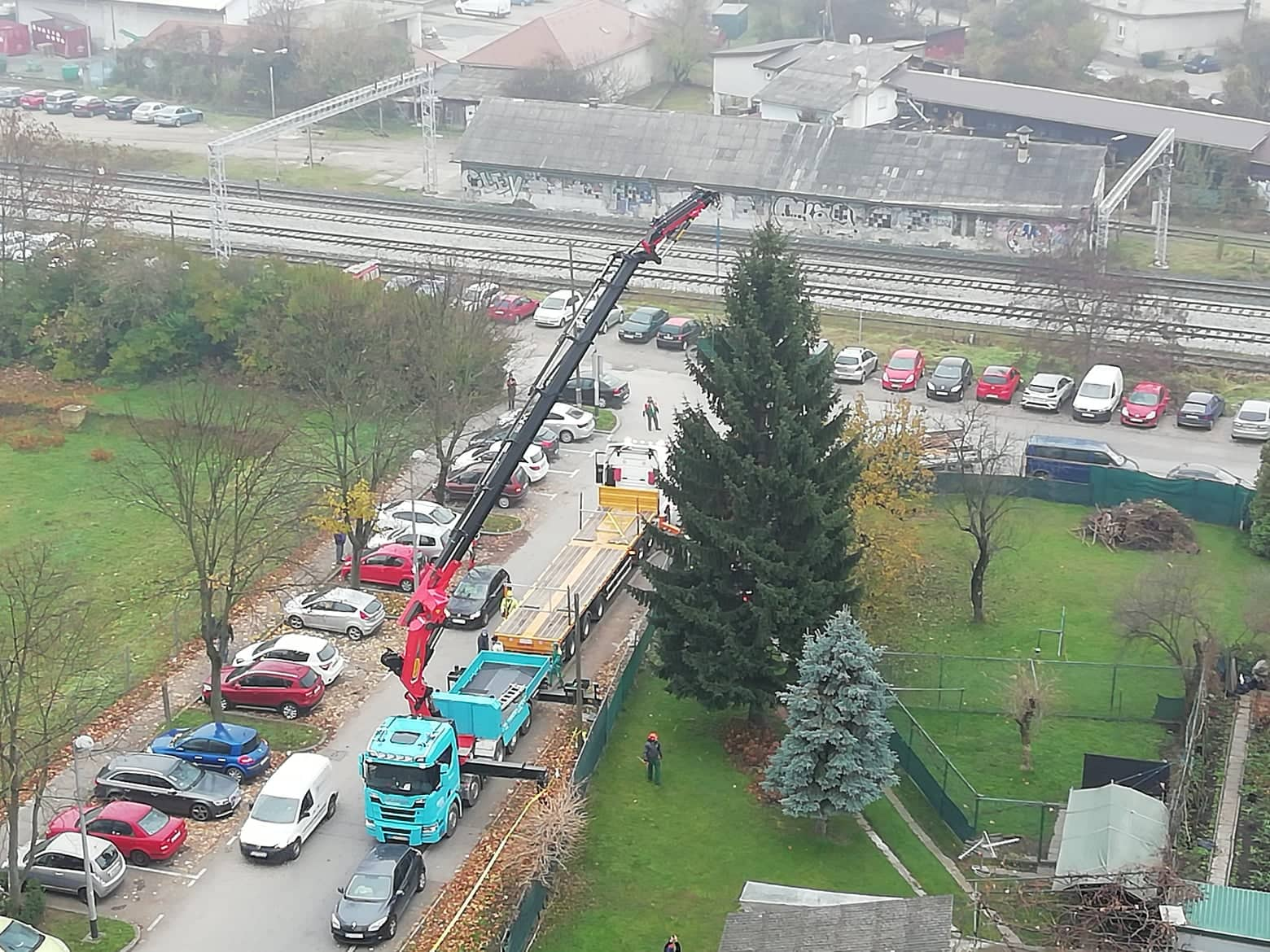
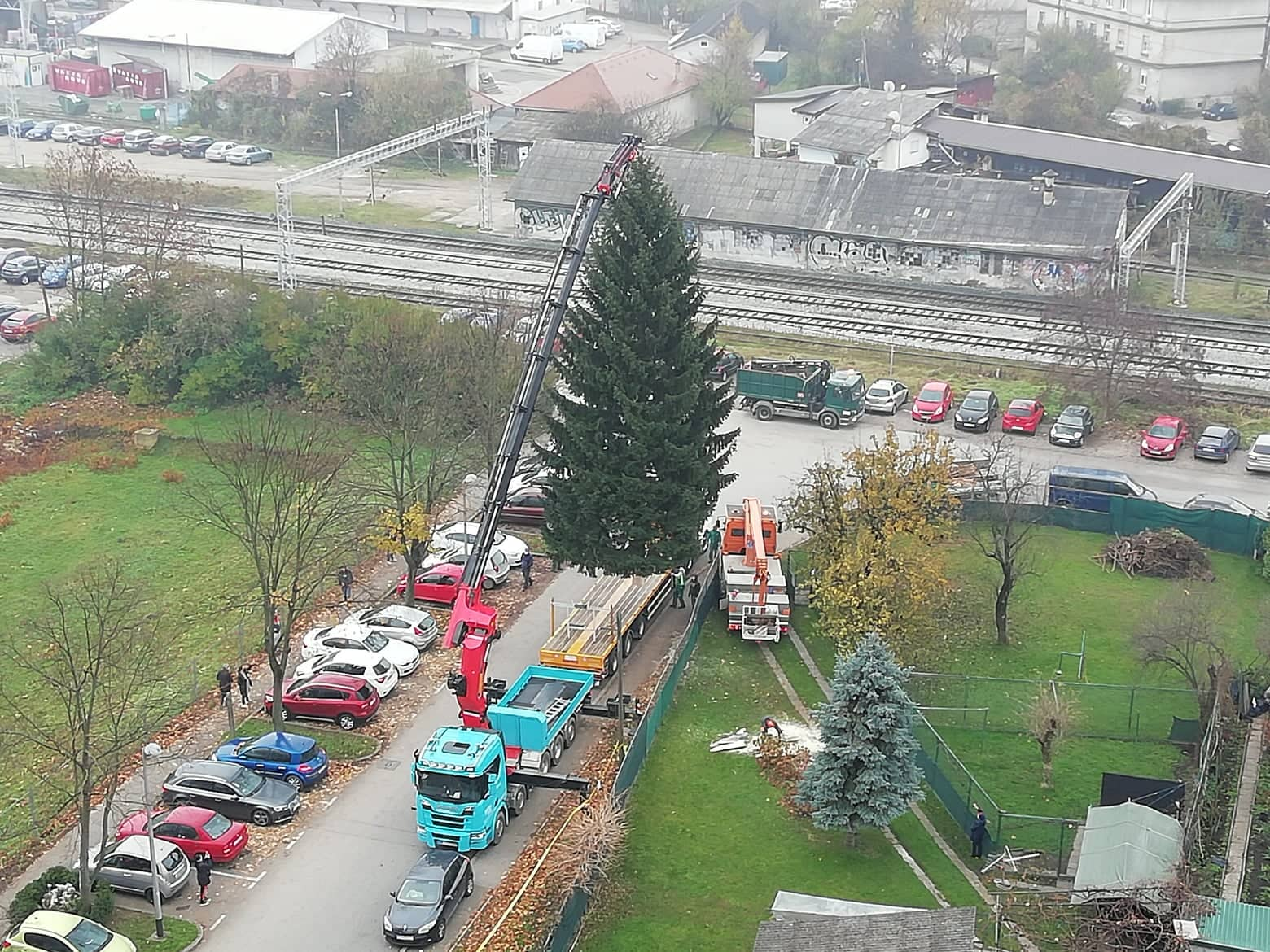
This article's final two photos were taken by © Zoran Stajčić
When Starts Christmas In Croatia? Decorations Go Up Early Autumn
September 29, 2020 – One surprised shopper couldn't help but laugh and photograph as telltale signs of Christmas in Croatia appeared this week over her local supermarket
As long had been suspected by city residents, it has been officially announced that Zagreb's world-famous Advent celebrations will this year go ahead. Replanned under epidemiological guidelines, kućice (small vending houses), stages and spectacular lights will once again bring the sights, scents, sounds, tastes and cheer of the festive season to the capital this December.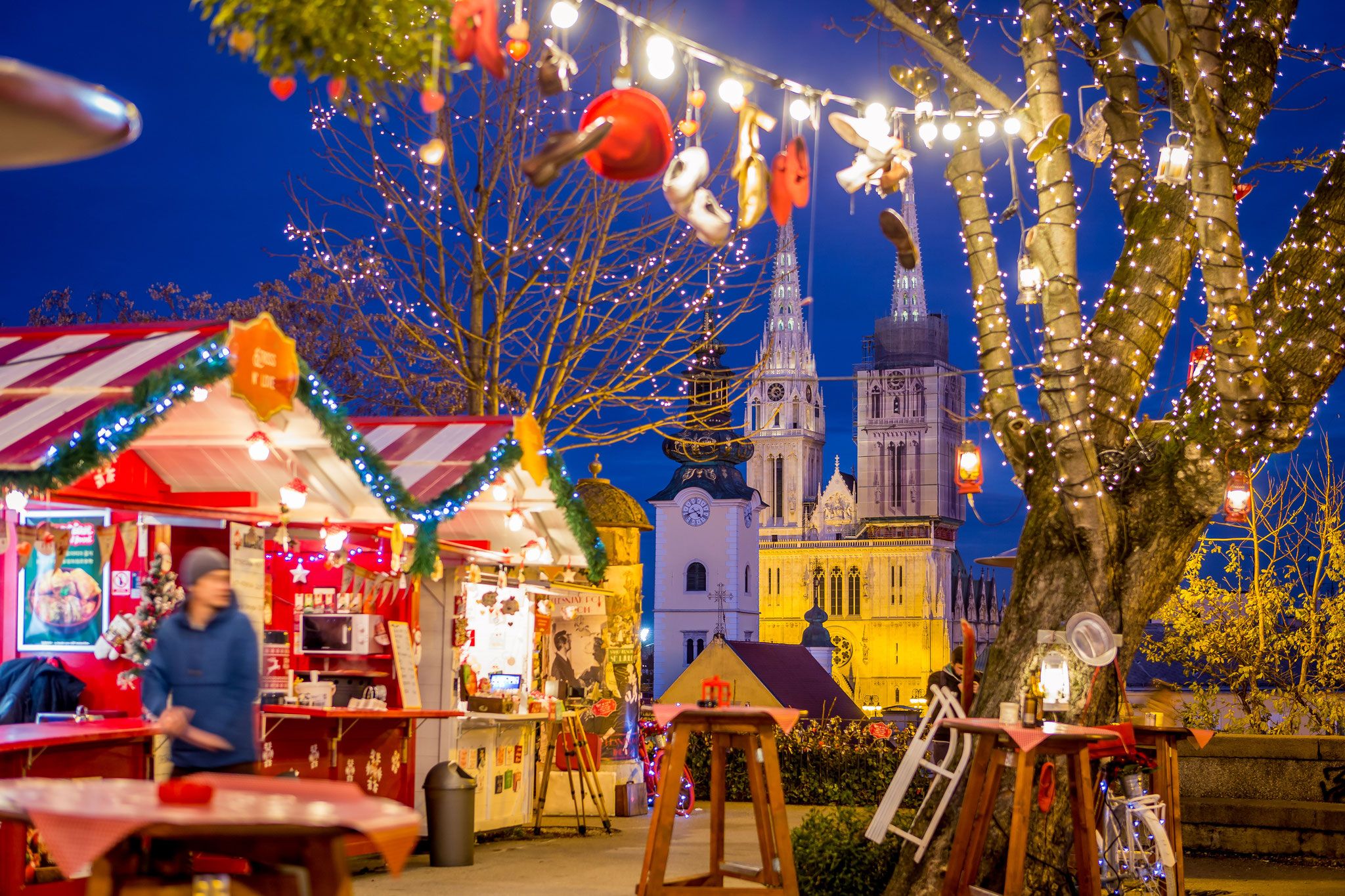 Advent in Zagreb © Julien Duval
Advent in Zagreb © Julien Duval
In the era of Coronavirus, you might be able to ask people to be a bit quieter on their nights out, but there is absolutely no chance you can hold back Christmas in Croatia.
With Zagreb Advent now lasting for over one month - from the last day of November to the end of January's first week - the festive season is already stretched quite far, perhaps reflecting just how much residents enjoy Christmas in Croatia. But, this year, the marking of Yuletide has started earlier than ever before.
The setting of the late summer sun seems to have been the signal for one supermarket to begin bringing in the Christmas cheer. One surprised shopper couldn't help but laugh and photograph yesterday when she saw that Christmas decorations had already appeared over her local supermarket in Dubrava, east Zagreb. It is only the first week of autumn.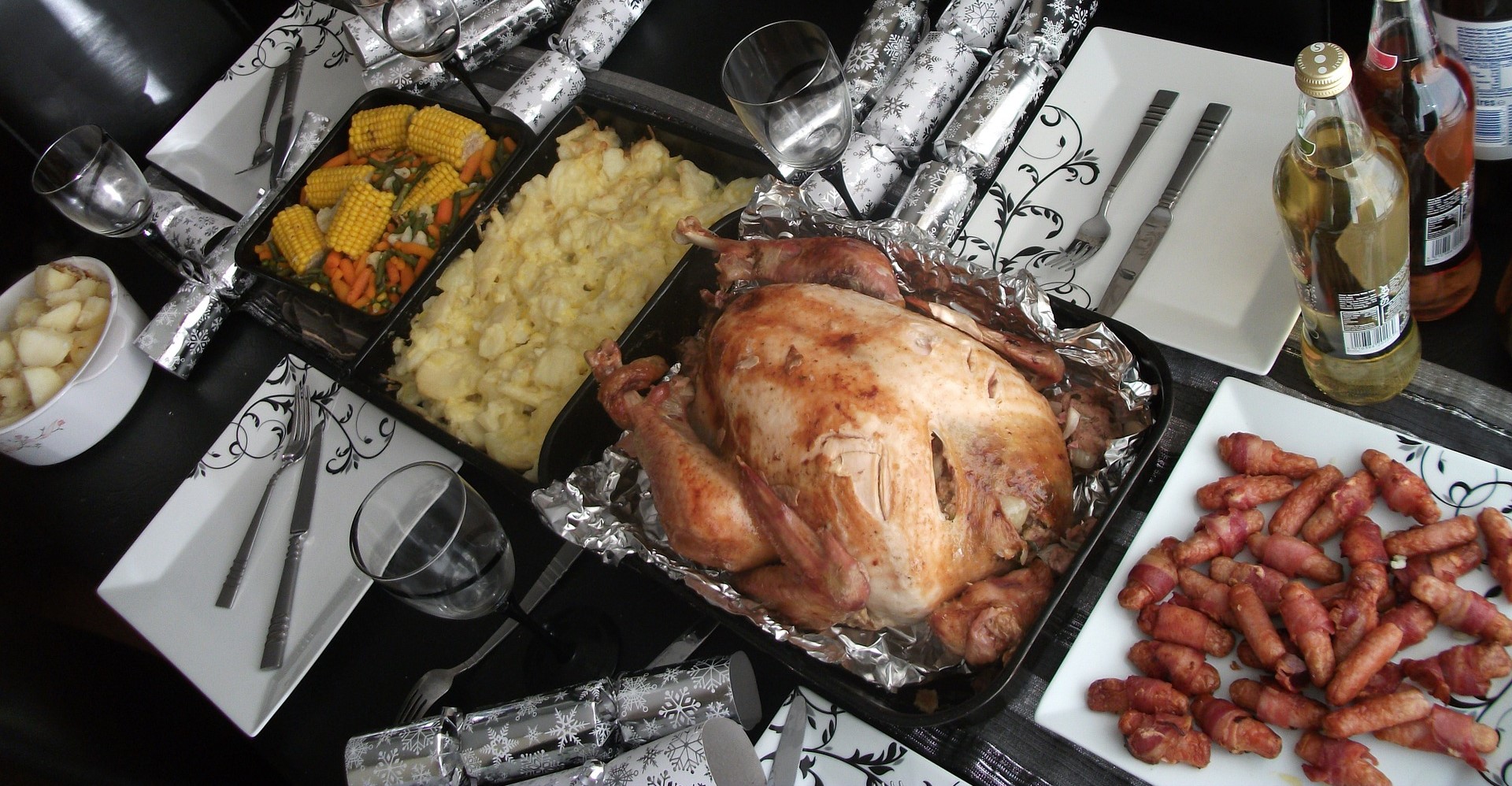 If you are invited into someone's home over Christmas in Croatia, you simply must go - the atmosphere and food are usually fantastic © Pictureday
If you are invited into someone's home over Christmas in Croatia, you simply must go - the atmosphere and food are usually fantastic © Pictureday
Christmas in Croatia is an excellent time to visit. Zagreb's Advent has consistently been voted the best of its kind across Europe. The season of goodwill in the country is one where gifts are exchanged, homes visited, feasts shared and superb culture enjoyed. As a Catholic nation with a strong sense of family, it is also a time where religion is observed and when you get to see all of your relatives. Many visitors to Christmas in Croatia are lucky enough to be invited into the home while they are here, and such an opportunity should not be turned down. Being among family members and friends, eating traditional and homecooked Croatian food is an unforgettable Christmas experience. But, there are some rules.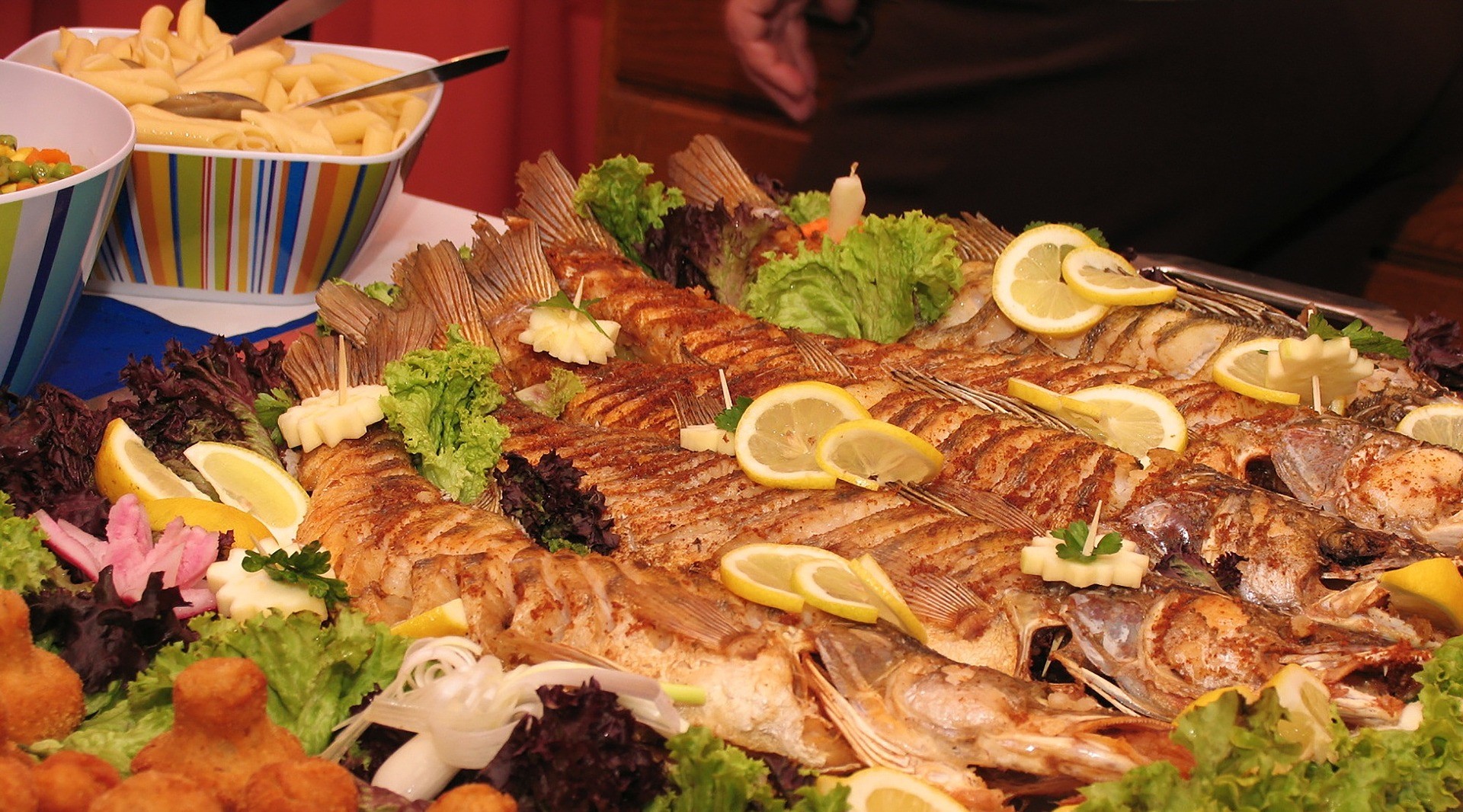 Religious tradition is an integral part of Christmas in Croatia. In almost every home, no meat, only fish, is eaten on Christmas Eve © Vargazs
Religious tradition is an integral part of Christmas in Croatia. In almost every home, no meat, only fish, is eaten on Christmas Eve © Vargazs
In the UK, it's very common to greet friends across many days of December with “Merry Christmas”. You don't do that in Croatia. If you do, you'll be met with a look that lies anywhere between confusion and concern for your mental health. The greeting of “Merry Christmas” is strictly reserved for Christmas Day itself.
The root of this adherence to tradition is doubtless the acknowledgment that Christmas in Croatia is, above all, a religious festival. Croatians are often more attuned than most to commercialism creeping into what remains a deeply-observed marking of Jesus's birth. Yet, somehow, this most sacred of Catholic holidays manages to comfortably sit, side by side with seasonal celebrations that extend further each year. Although, the first week of autumn as the start of Christmas in Croatia must be the earliest one yet.
For the latest travel info, bookmark our main travel info article, which is updated daily.
Read the Croatian Travel Update in your language - now available in 24 languages
Billion Kuna More Spent in December 2018 Than December 2017
Just how much did you spend for Christmas 2018? Croats spent a massive billion kuna more during this festive season than they did during the festive season before it, which sends out a positive signal.
As Poslovni Dnevnik writes on the 2nd of January, 2019, consumption in December 2018 reached record 14.85 billion kuna, up 7.1 percent from the same period last year when the average consumer spending amounted to 13.79 billion kuna, according to data from the Croatian tax administration. This marks an impressive billion kuna increase.
"This increase of over one billion kuna is in line with the estimates of the Croatian Chamber of Commerce (HGK). The rising of wages and their growth through tax reform(s) acted upon the optimism of citizens and also on consumption. We also had a good tourist season, which also works in favour of this year's record-breaking December,'' said HGK's Tomislav Ravlić.
She stressed that this contribution to public spending has increased as more and more employers have decided to pay their employees a higher salary, accompanied by bigger Christmas bonuses and similar monetary measures.
According to the results of the Croatian Chamber of Commerce's research which was carried out last year, the largest number of respondents spent between 100 and 500 kuna on Christmas gifts (39 percent), followed by those who set between 500 and 1000 kuna (31 percent) this year.
The upper limit of 1000 kuna was exceeded 9 percent of people, while less 21 percent of the respondents spent less than 100 kuna. Almost 40 percent of people left toys and similar items under the Christmas tree in December 2018, with cosmetics (37 percent), footwear and clothing (36 percent) and delicatessen food products (25 percent) following.
As positive trends are appearing to continue, will 2019's festive season manage to outdo this one?
Make sure to stay up to date with our dedicated business and news pages for much more on consumerism in Croatia, spending trends, doing business and the business and investment climate.


